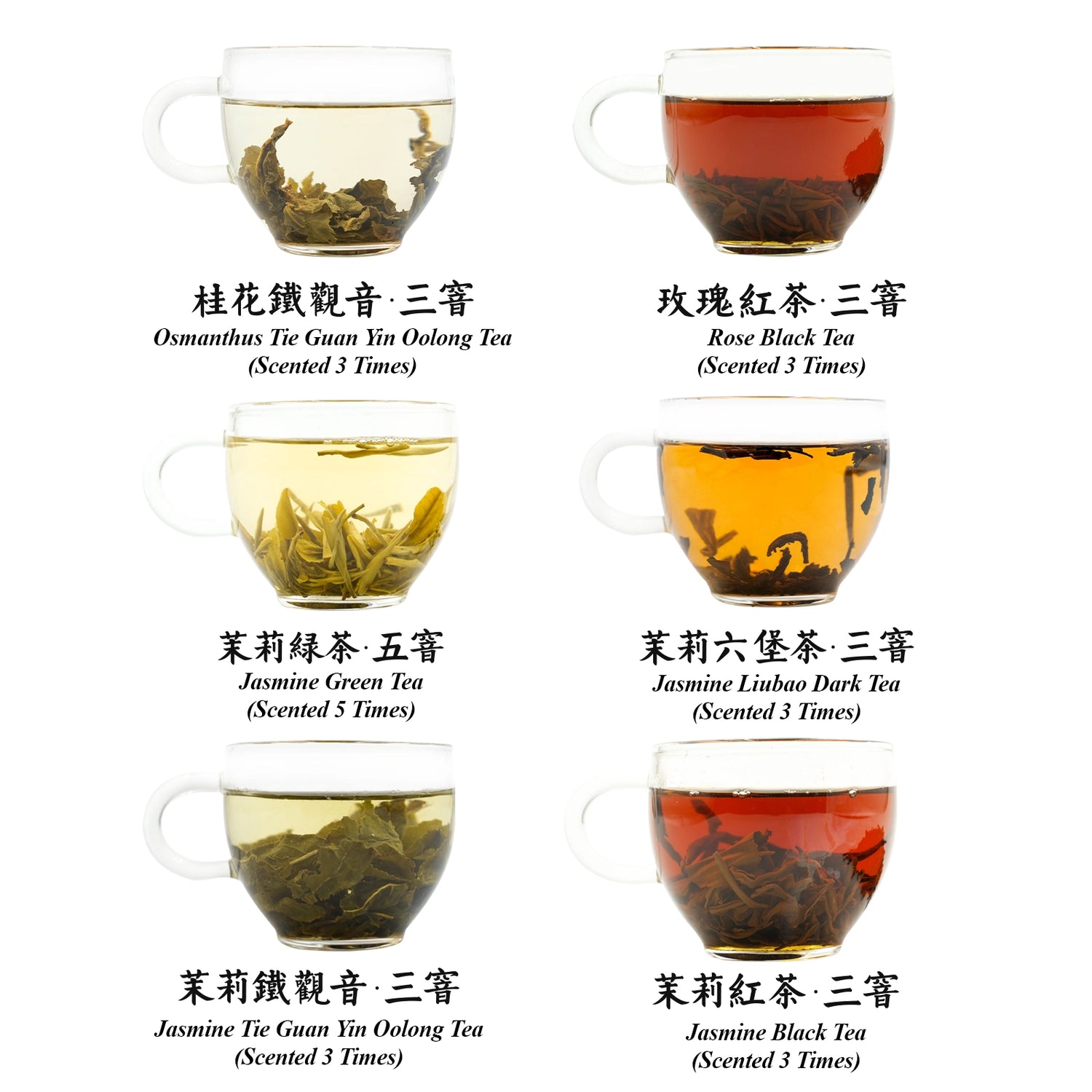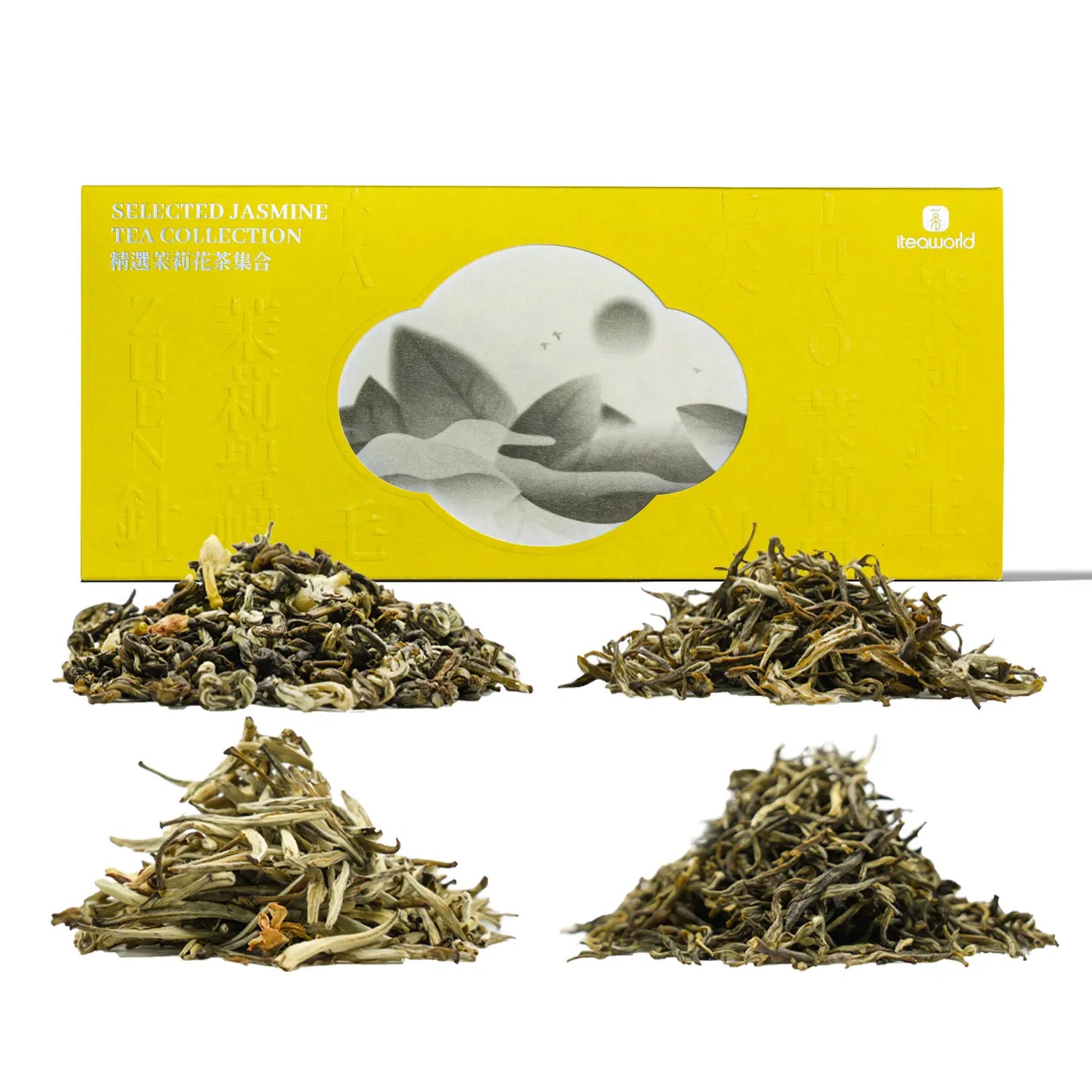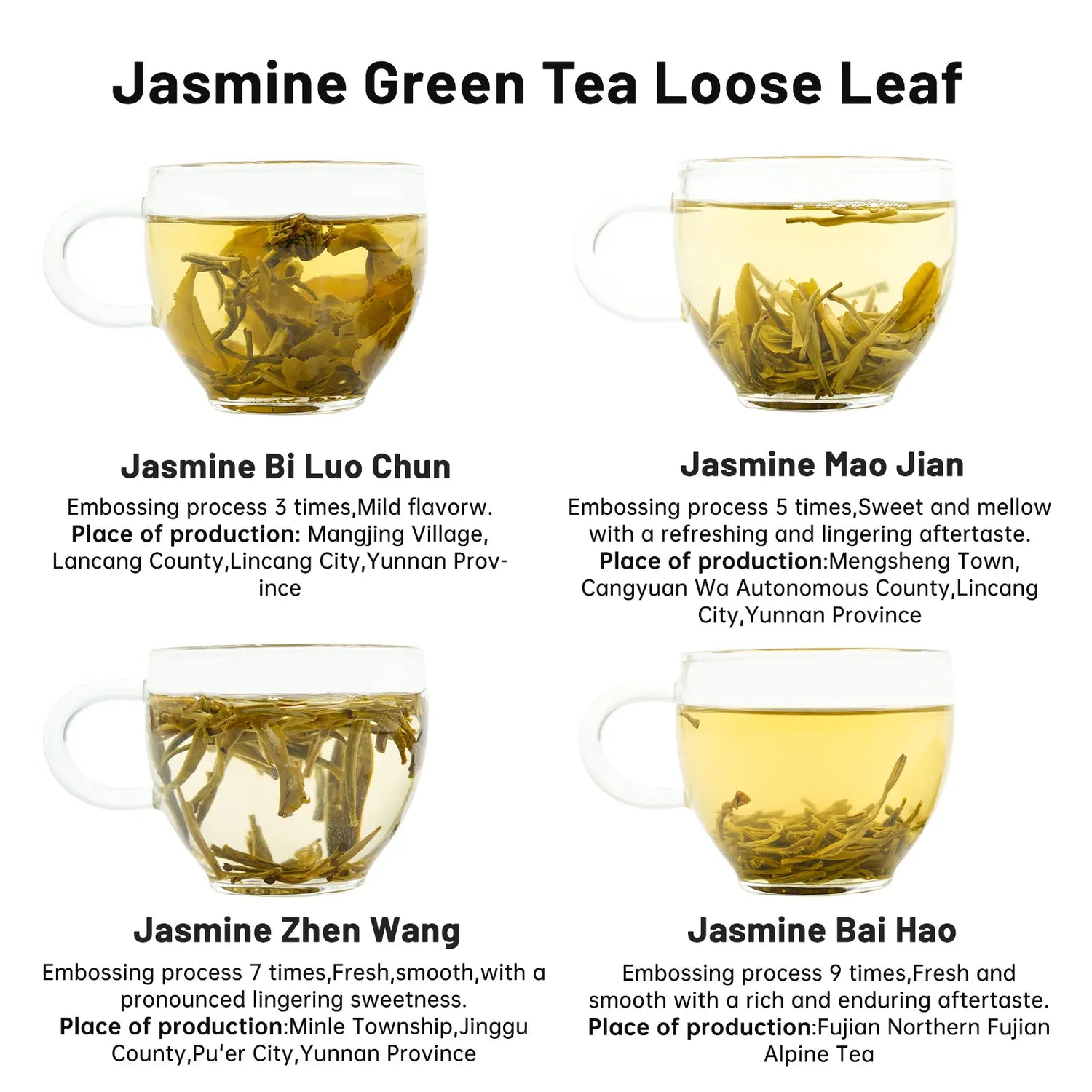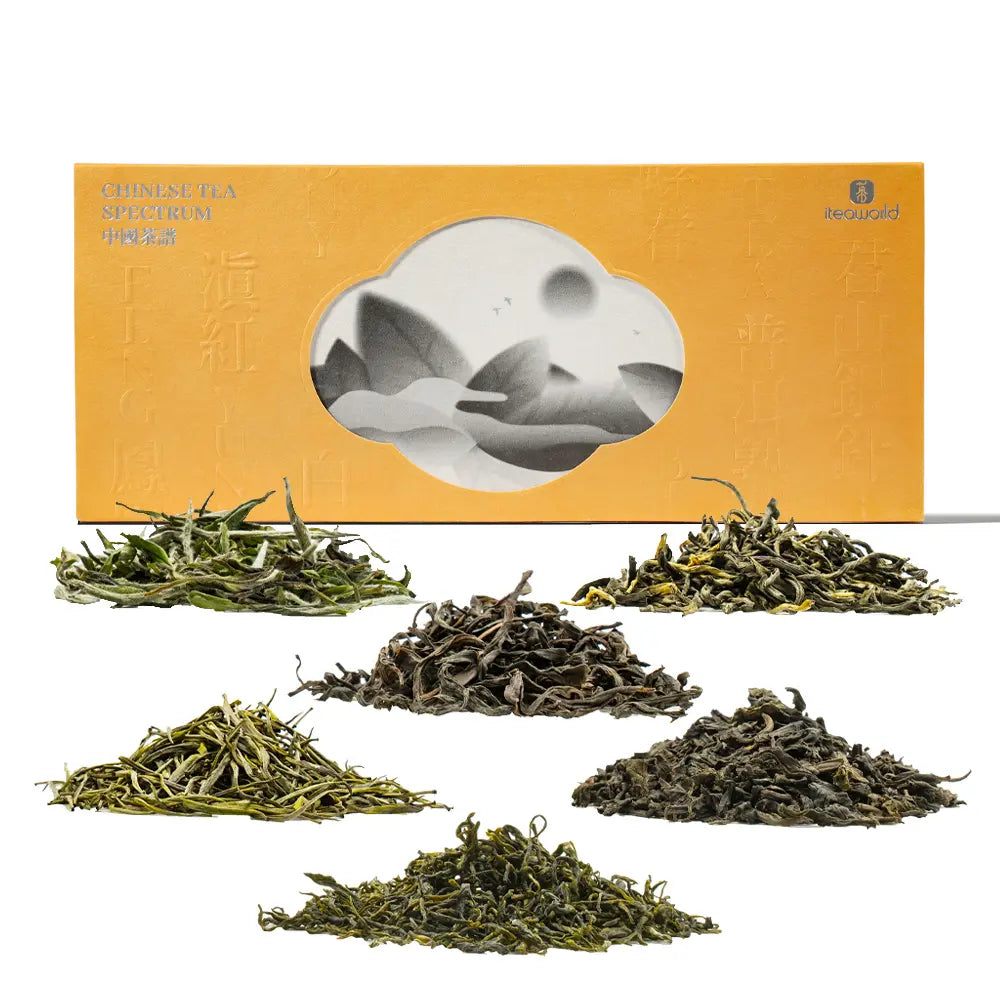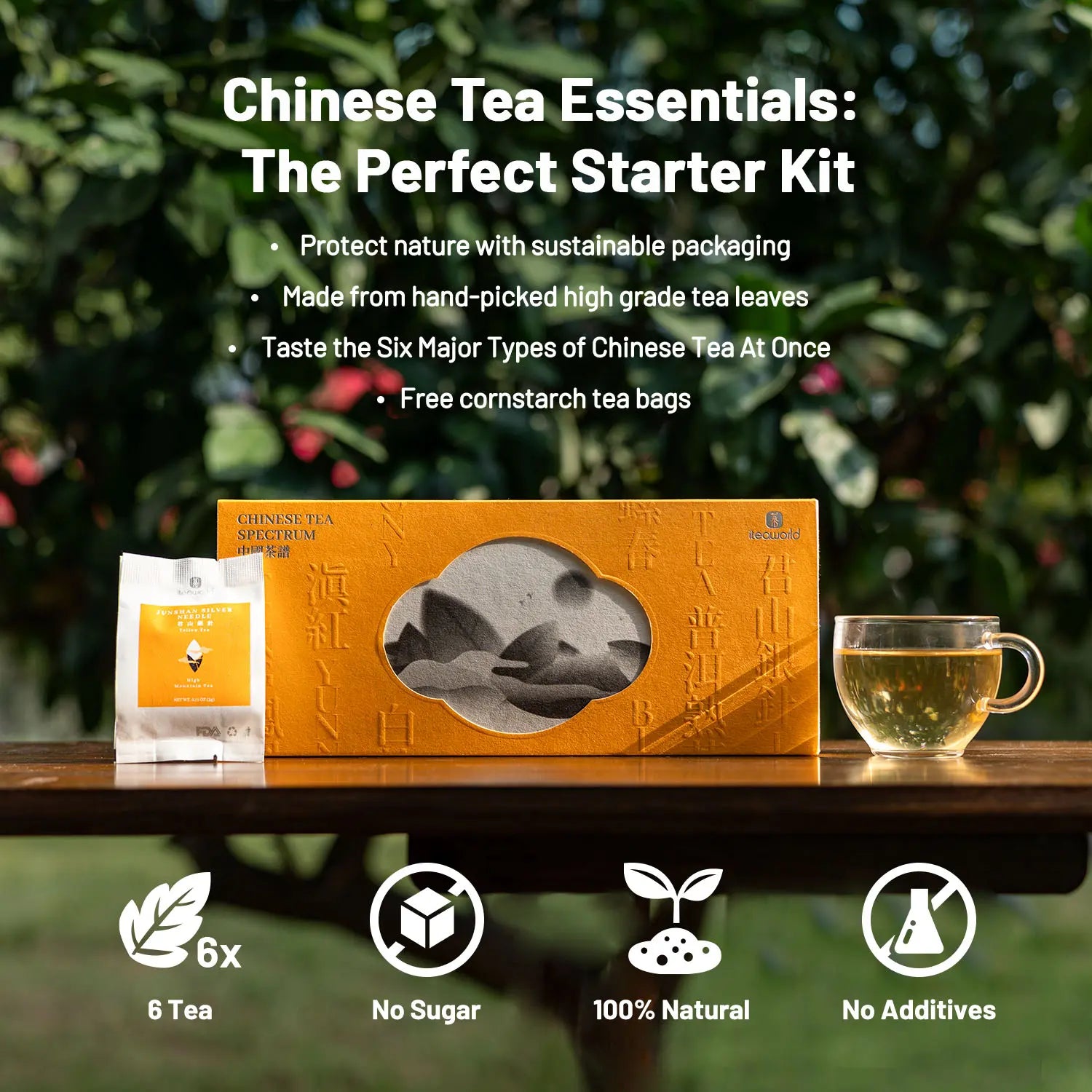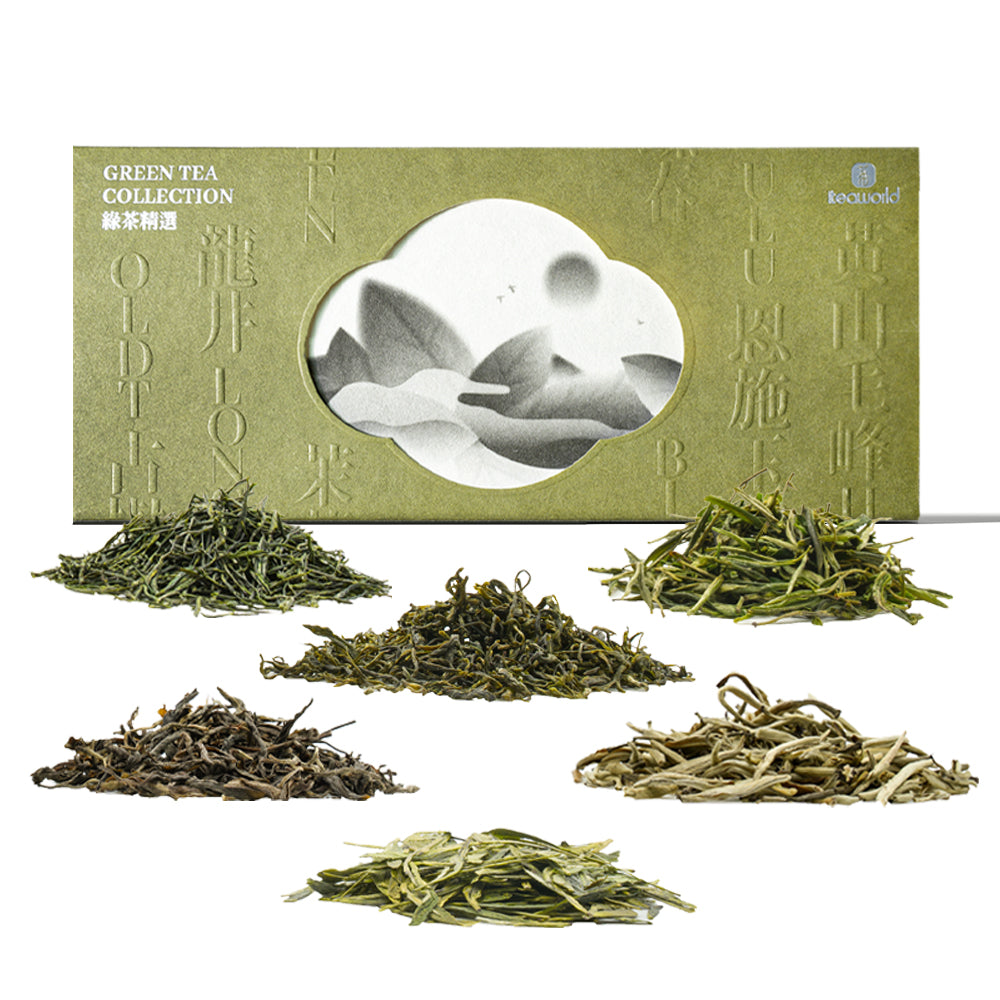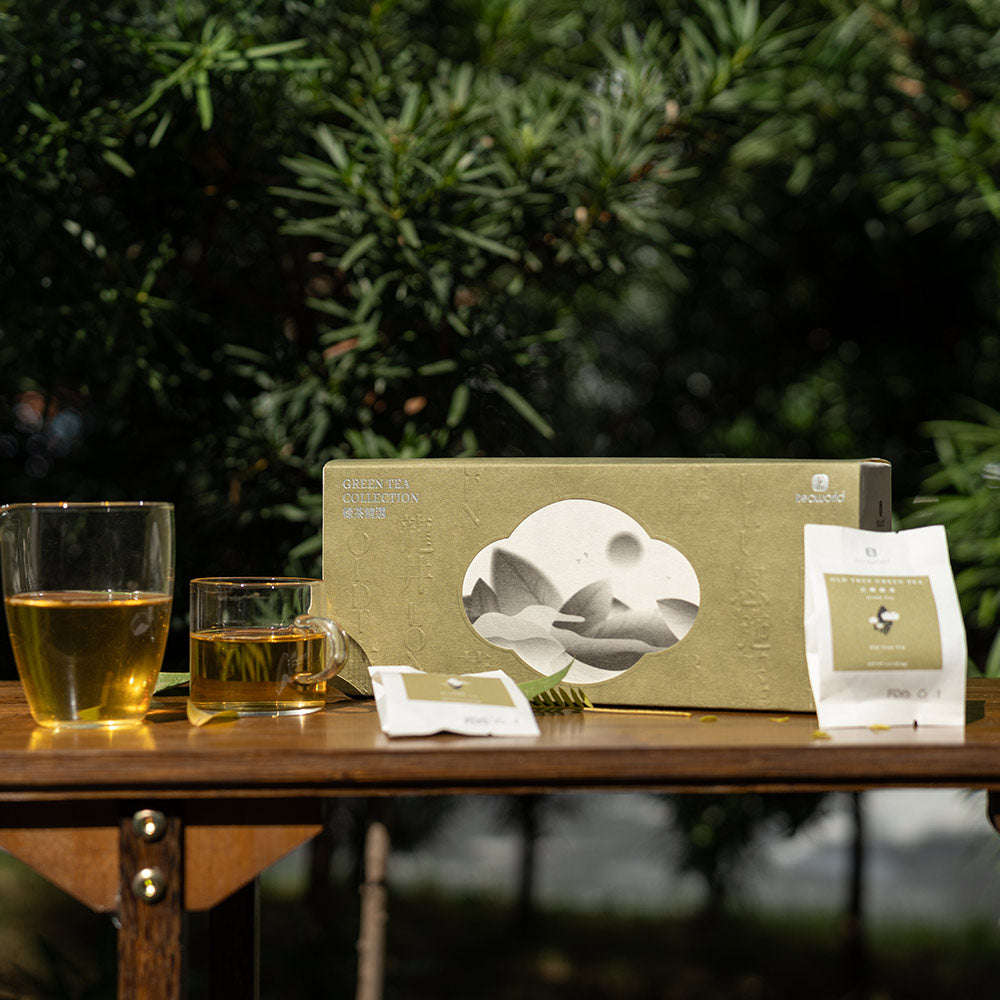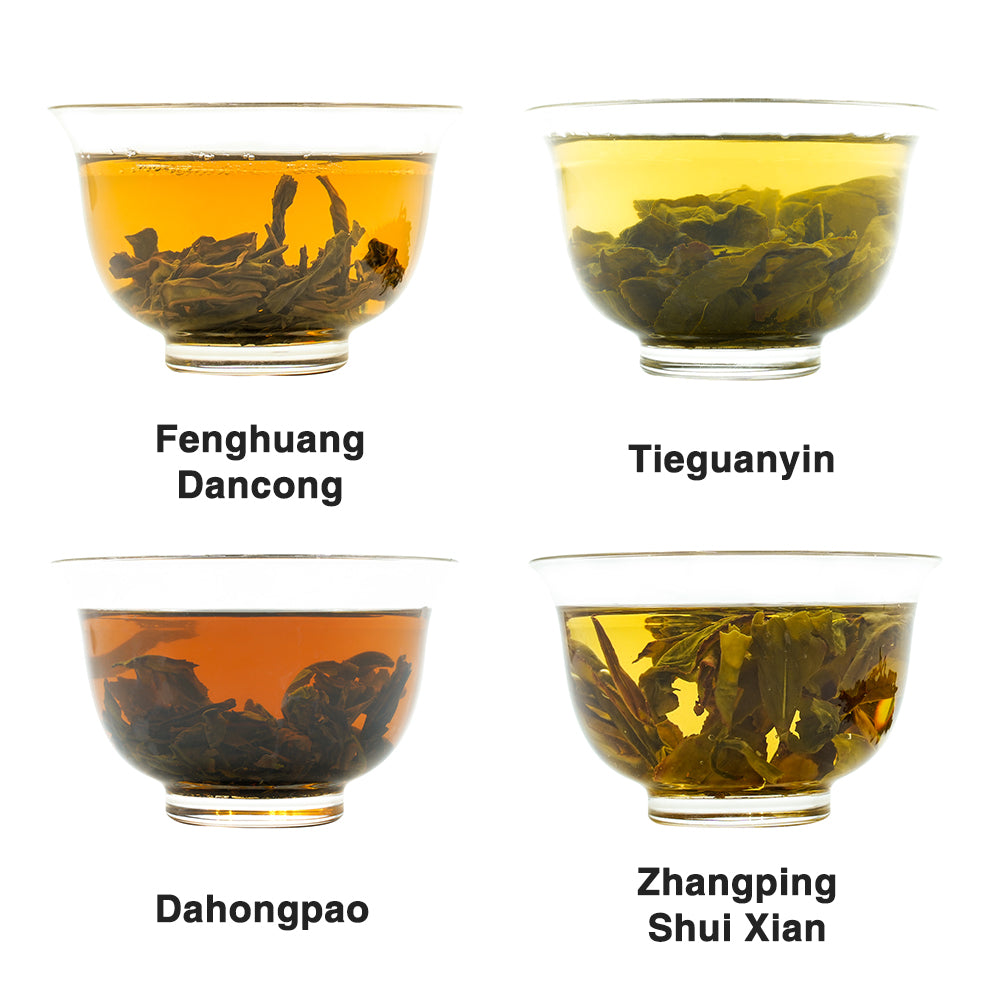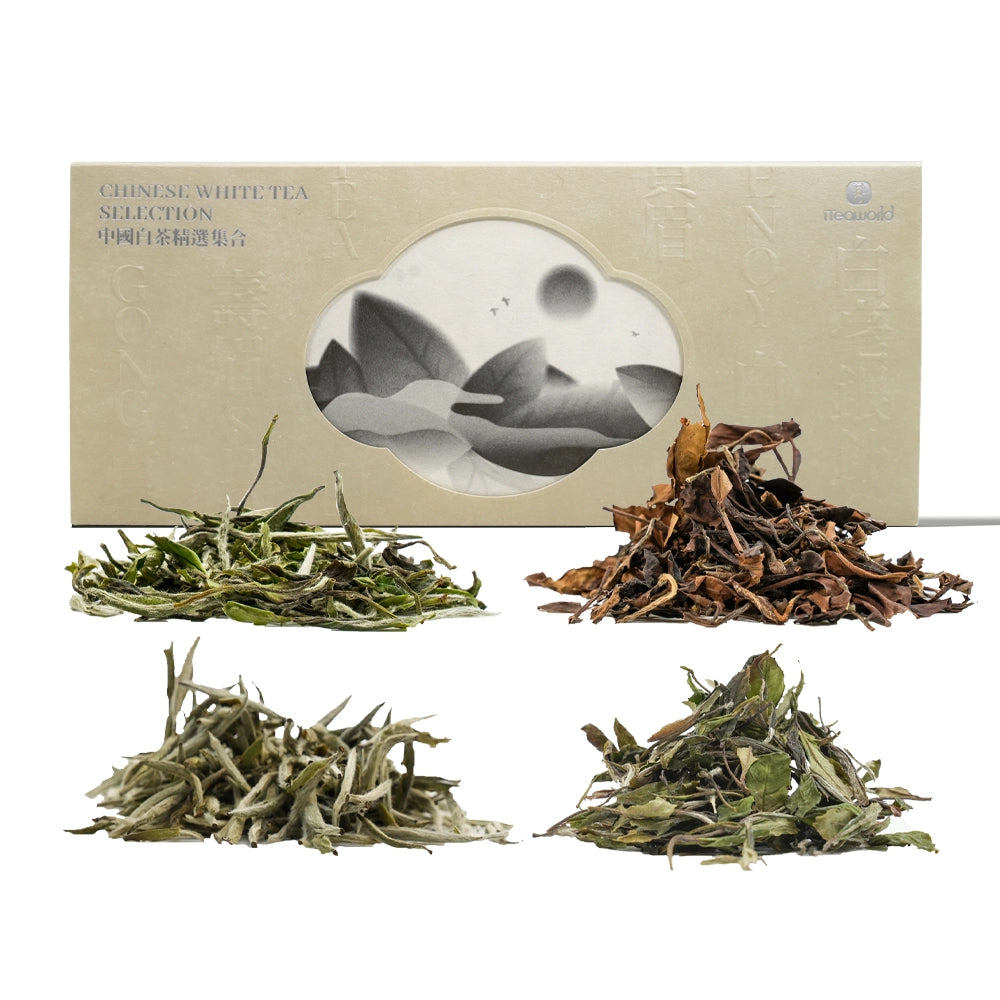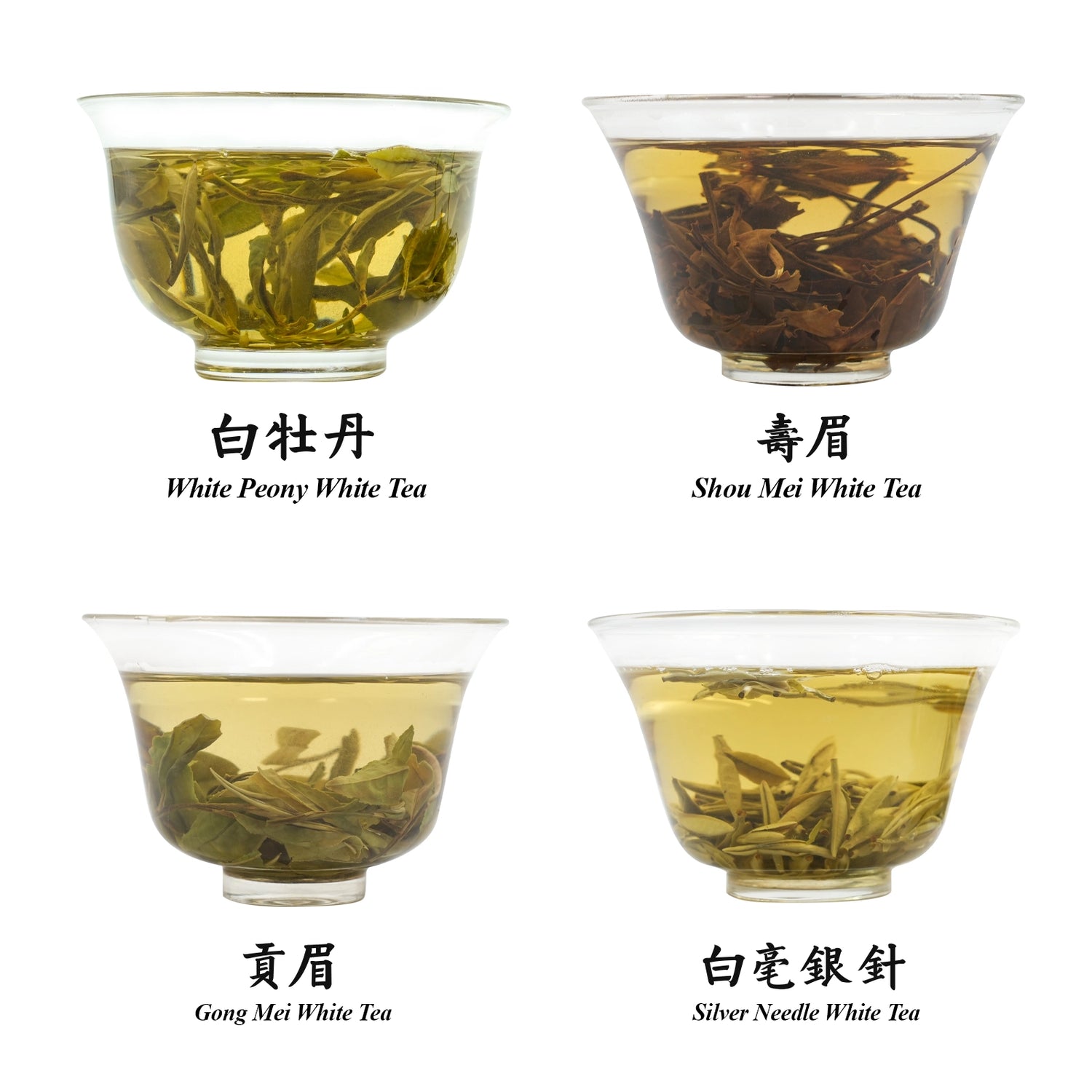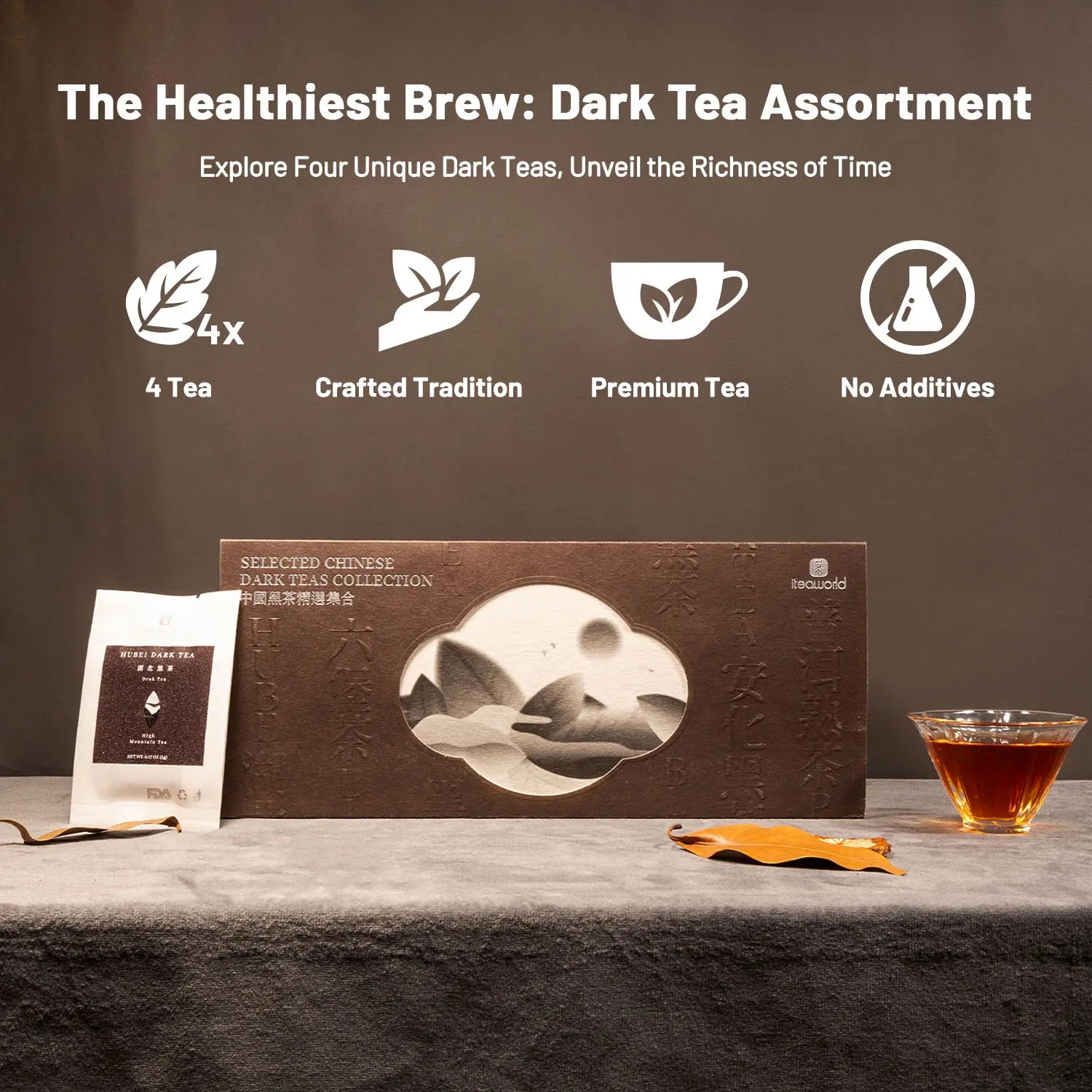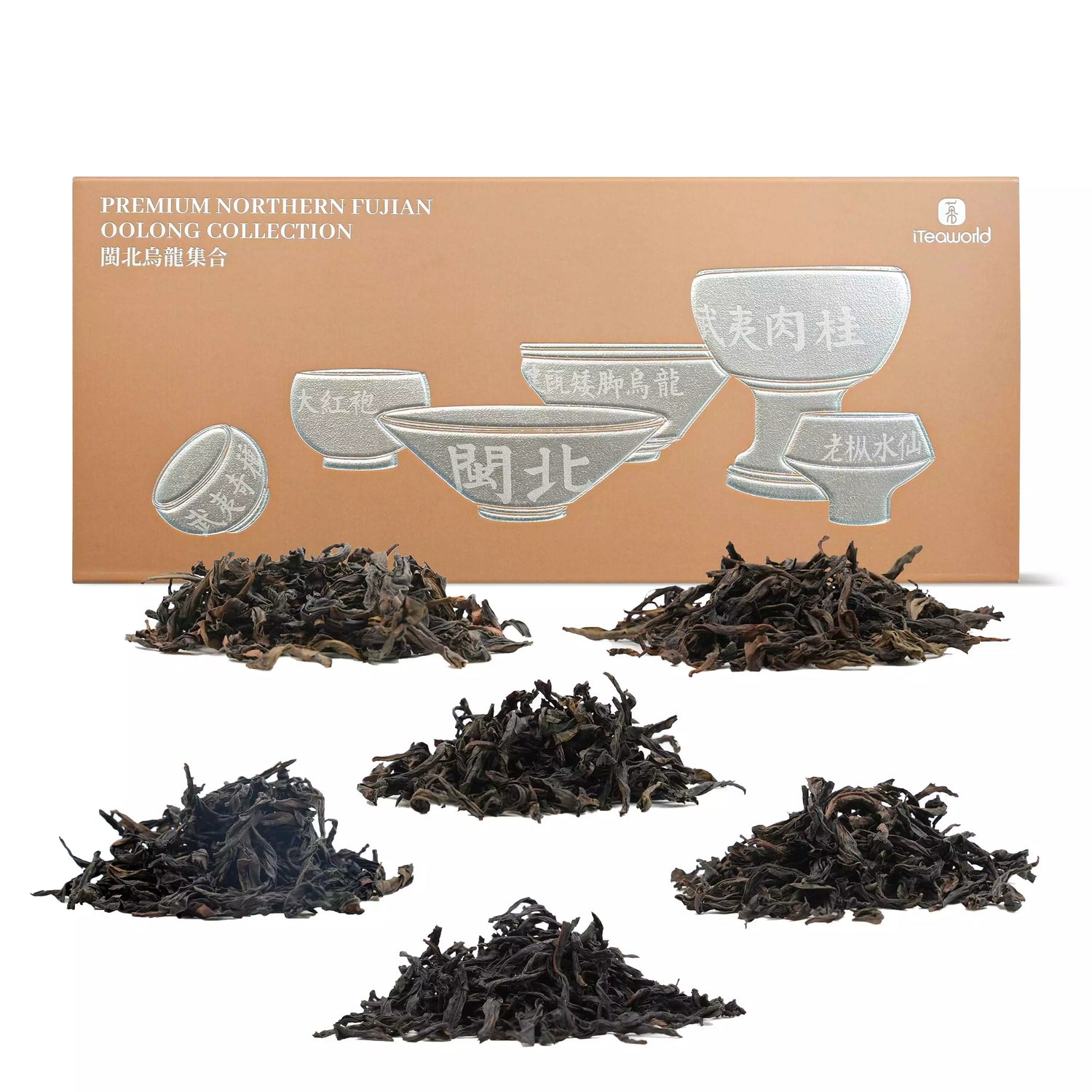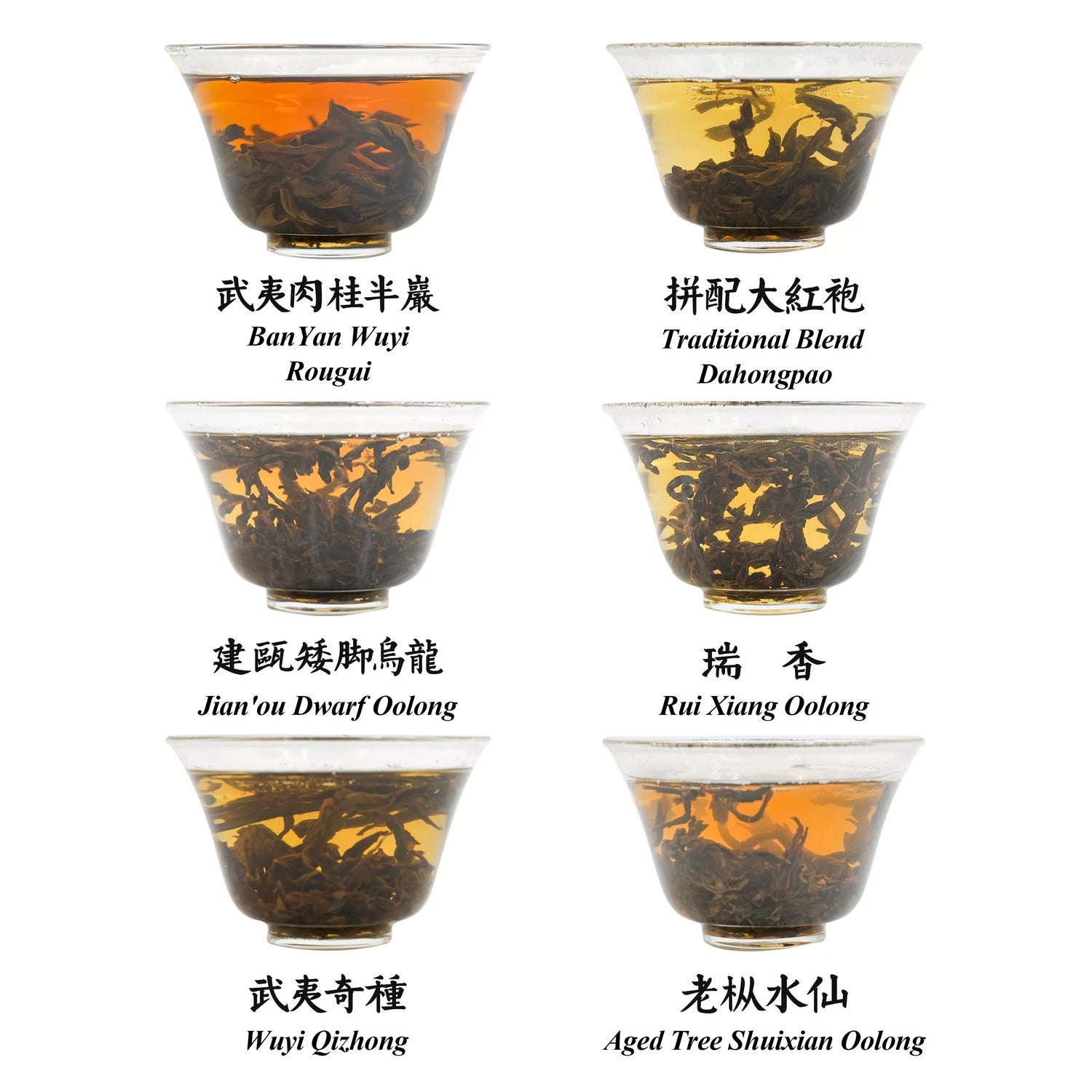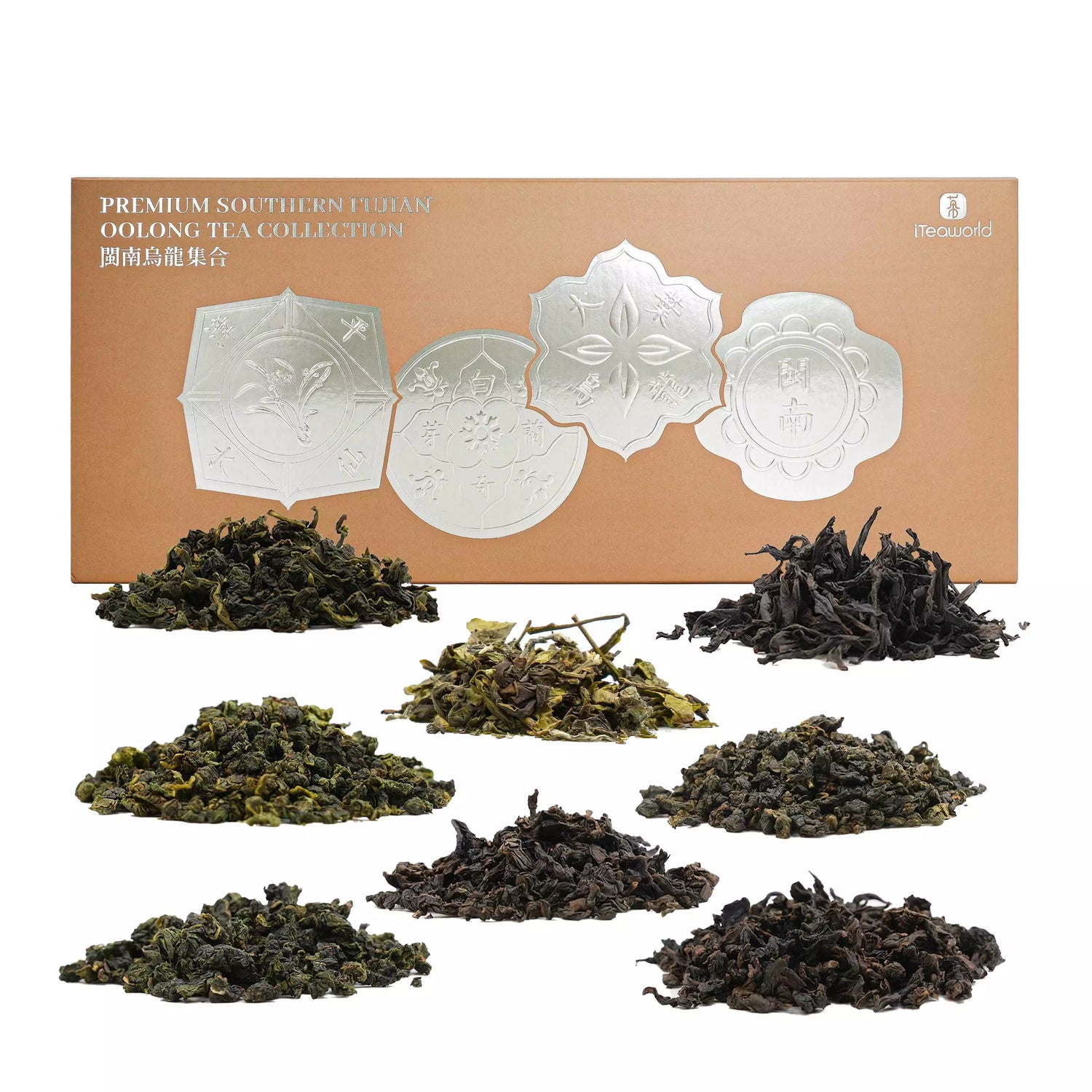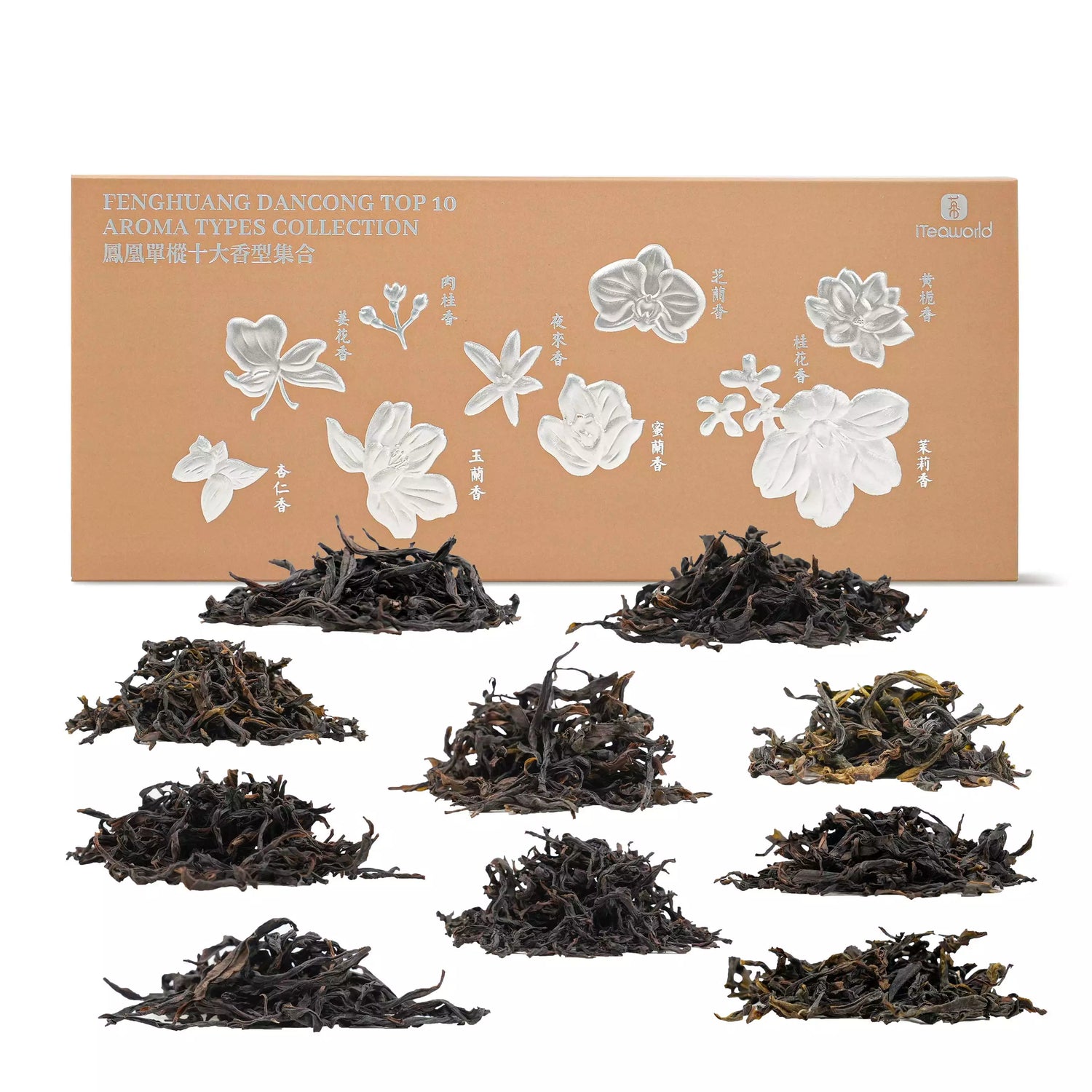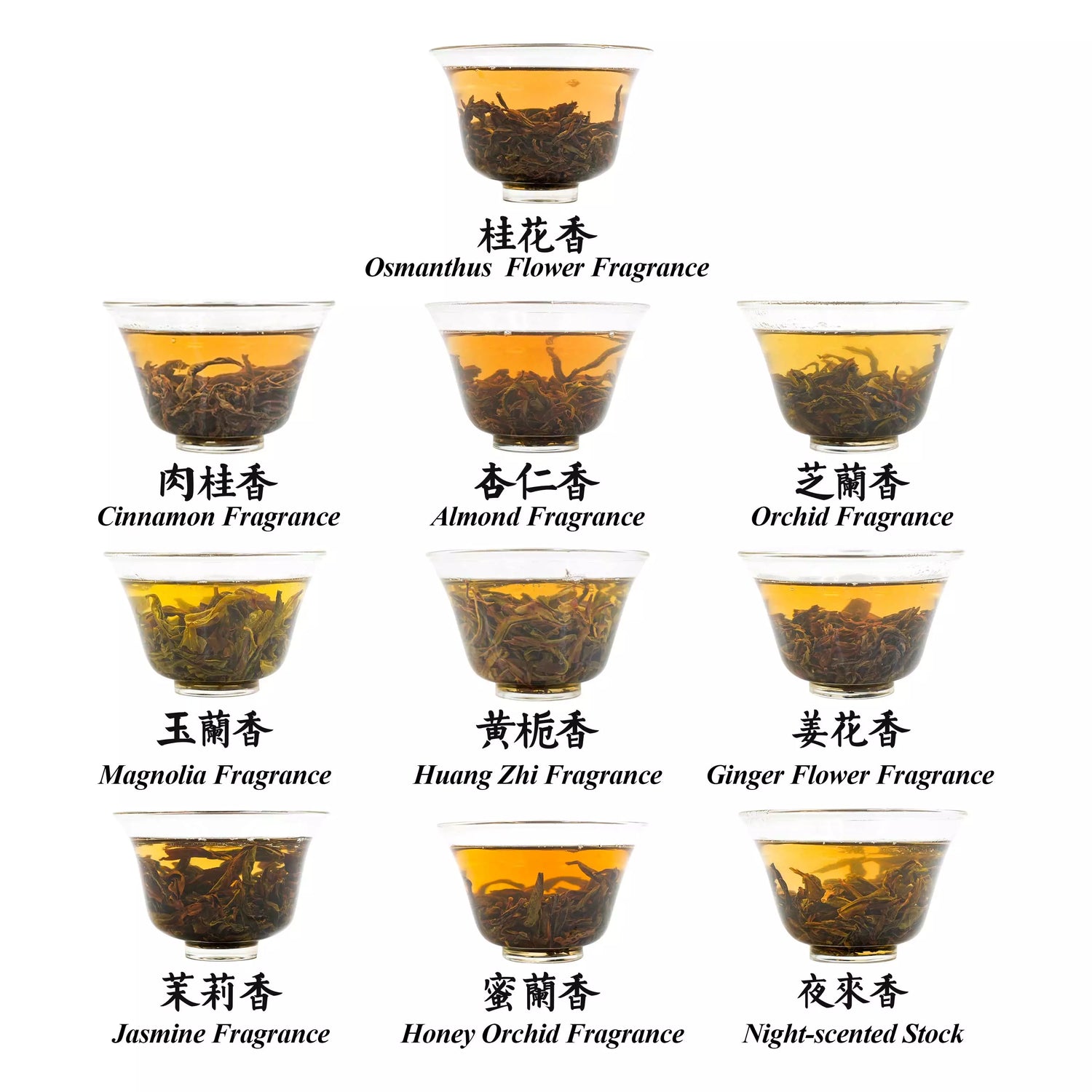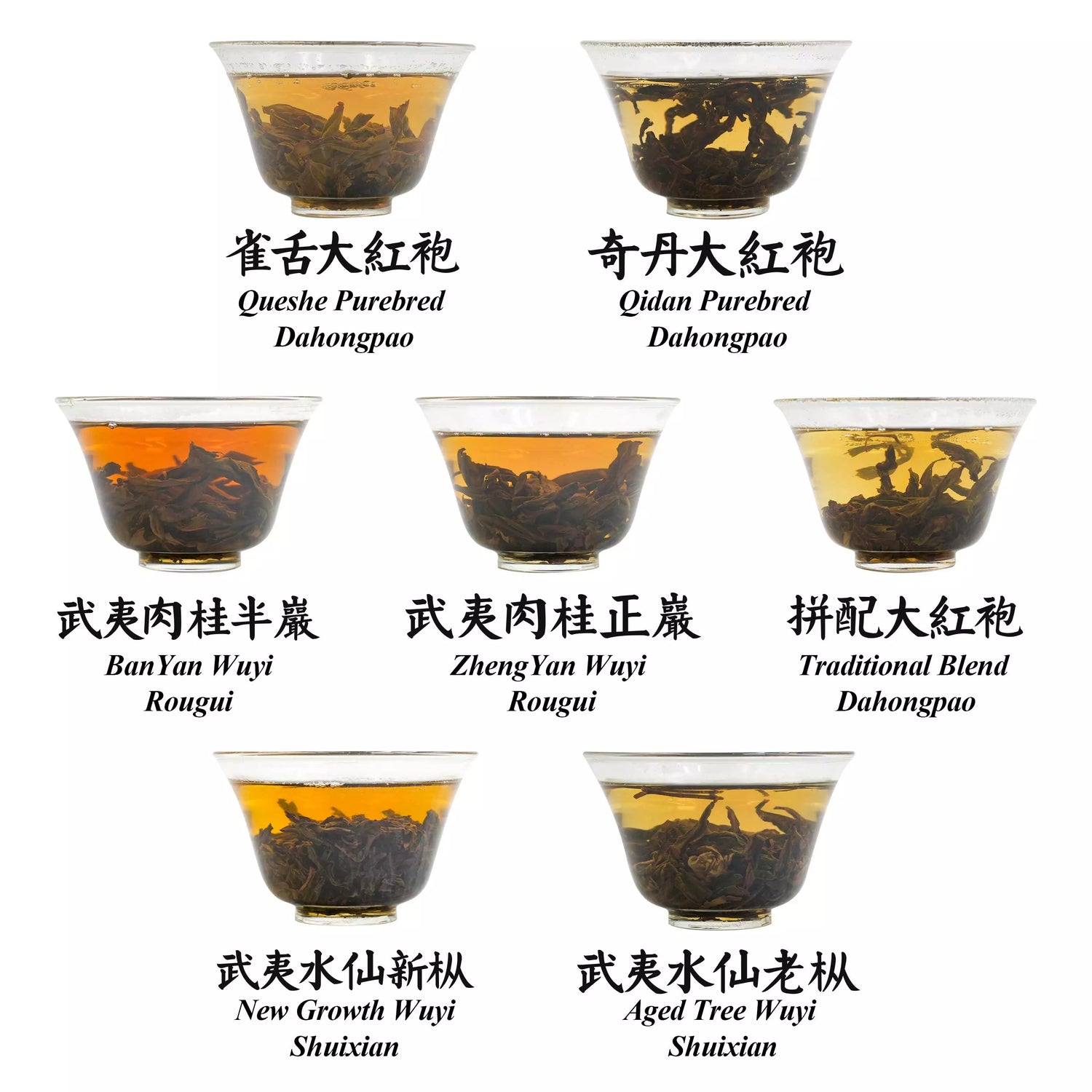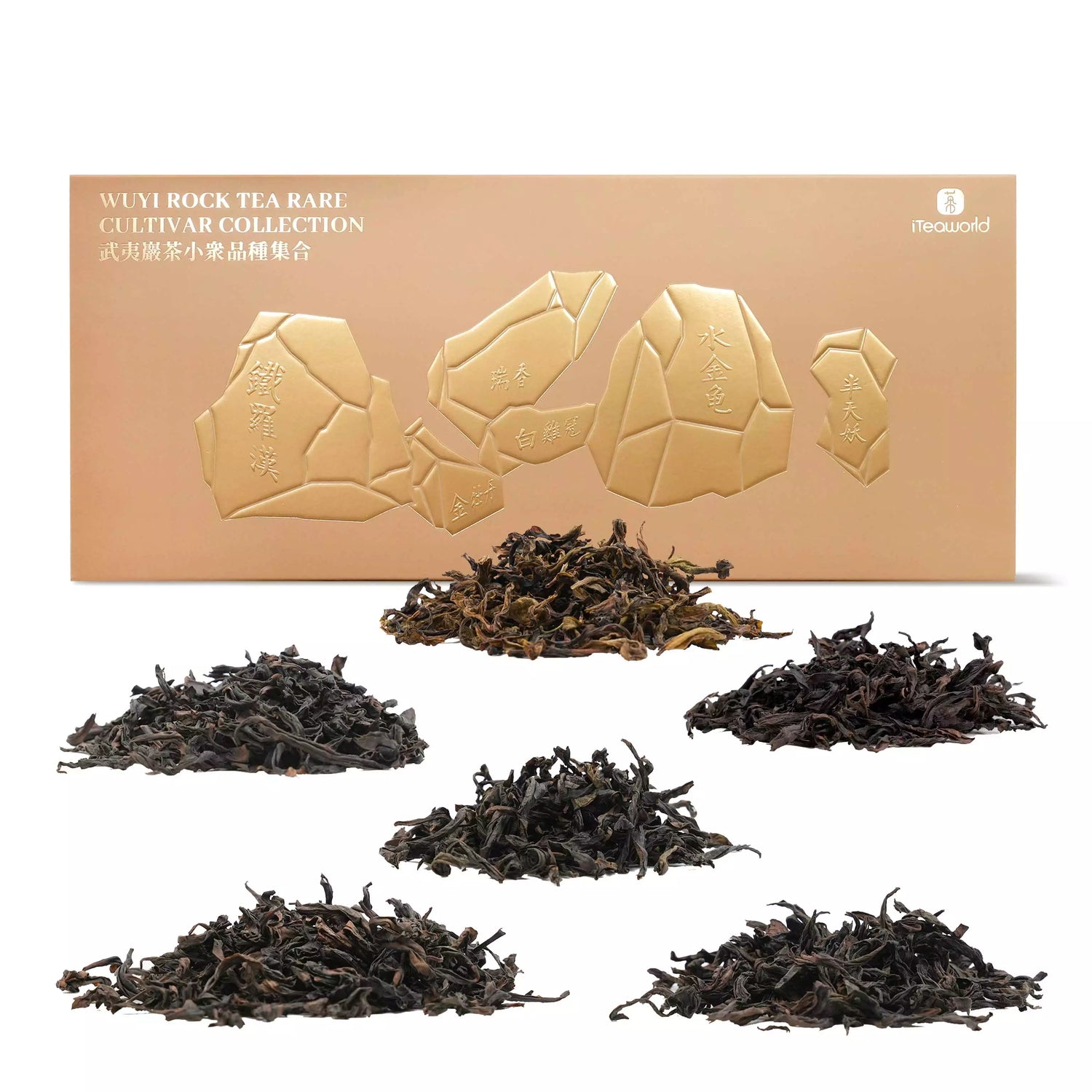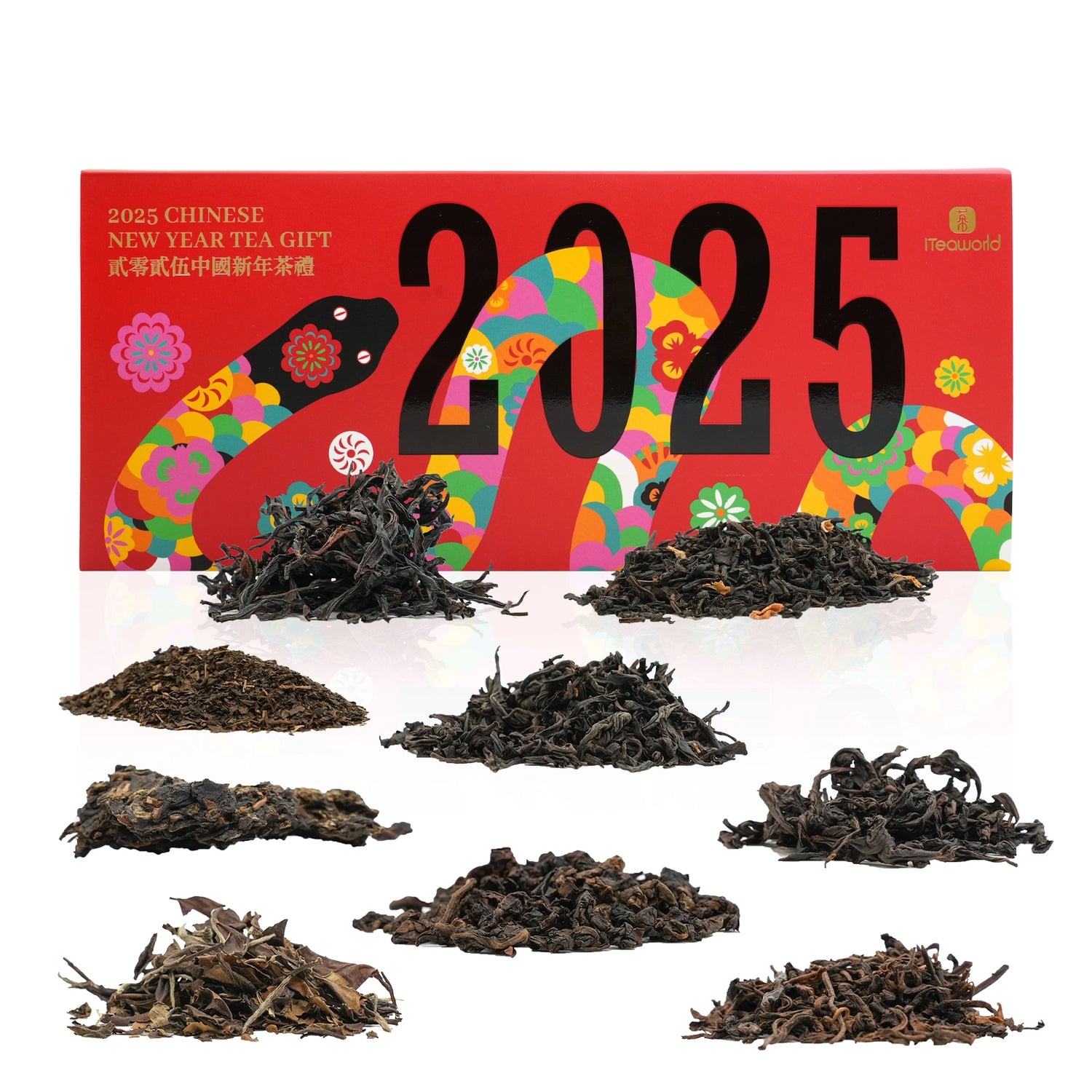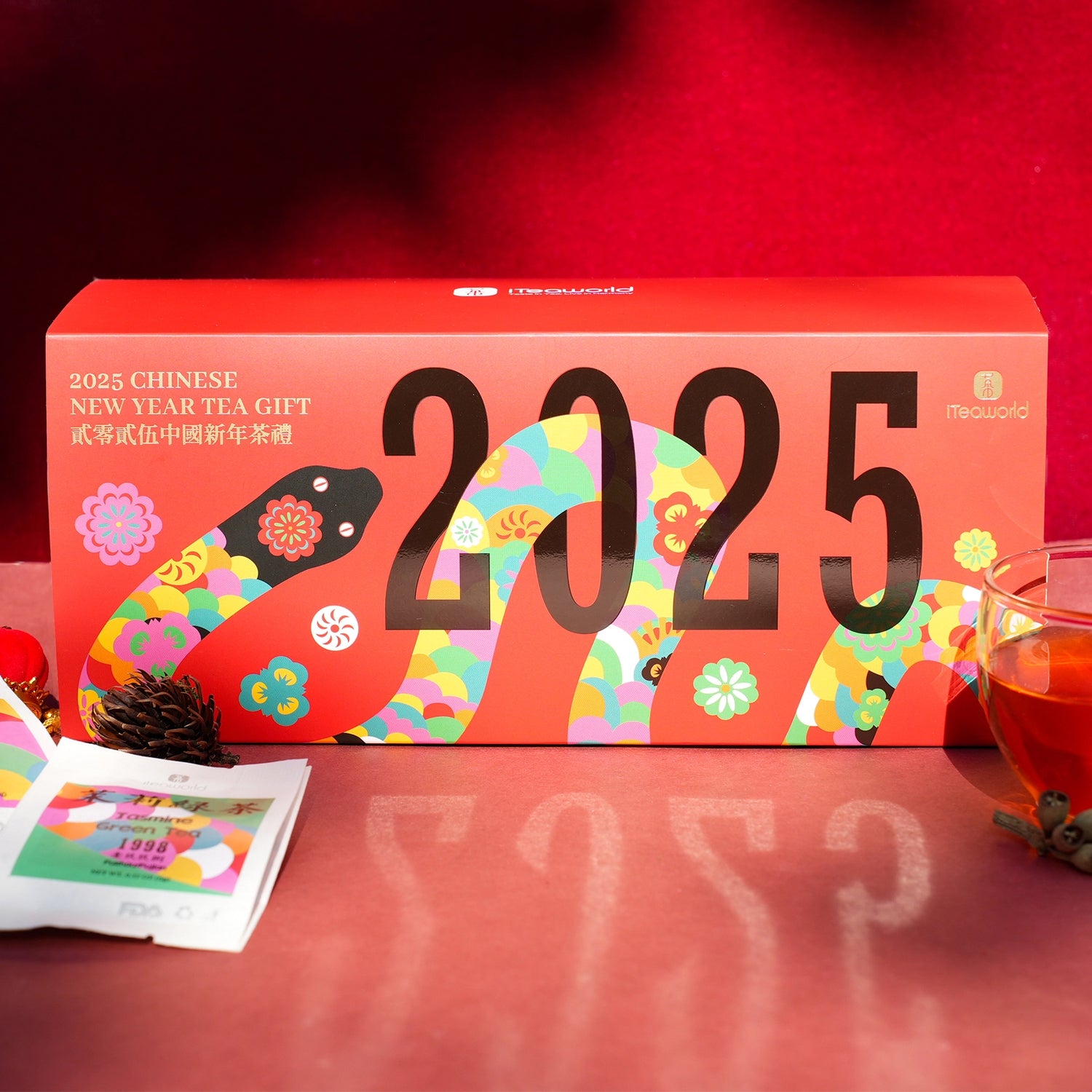16 products
16 products
Sort by:
This curated collection of Chinese scented teas celebrates the traditional craft of floral tea making, where premium teas are layered with fresh flowers like jasmine, rose, and osmanthus to infuse their essence. Through meticulous multi-round scenting (3-5 times), each tea offers a pure, natural floral aroma without a single petal in sight. Perfect for floral tea lovers or anyone curious about authentic Chinese scented teas, it includes six varieties: Jasmine Green Tea, Rose Black Tea, Jasmine Black Tea, Osmanthus Oolong, Jasmine Oolong Tea
and Jasmine Dark Tea. Ideal for gifting or indulging, this set combines rich heritage, delicate flavors, and the artistry of a UNESCO-recognized tradition. Not suited for those who prefer plain teas or are sensitive to floral fragrances.
Chinese Scented Tea Craftsmanship
"Scenting" is a traditional process where tea leaves are layered with fresh flowers, allowing the tea to absorb the floral aroma before the flowers are removed. This process is repeated multiple times to create the rich fragrance of high-quality scented teas. The best scented teas have no visible petals but retain the pure floral essence. By meticulously layering flowers and tea, ensuring proper aeration, and maintaining strict control over the scenting time and roasting process, the tea reaches peak flavor and aroma.
Depending on the number of scenting cycles—3, 6, or even 9 times—the tea's quality and complexity increase, with some processes taking up to a month. This craftsmanship, involving over 60 days and 200 steps, was recognized as an Intangible Cultural Heritage in 2022 for Jasmine Green Tea. While jasmine green tea is the original scented tea, modern innovation has expanded the range to include many beloved varieties.
This curated set features six of China’s most popular traditional scented teas, each crafted to perfection with vibrant floral aromas but no petals in sight:
- Rose Dianhong Black Tea (3 times scented): 3 packs x 5g
- Jasmine Dianhong Black Tea (3 times scented): 3 packs x 5g
- Osmanthus Aged Tieguanyin Oolong Tea (3 times scented): 3 packs x 5g
- Jasmine Fresh Tieguanyin Oolong Tea (3 times scented): 3 packs x 5g
- Jasmine Green Tea (5 times scented): 3 packs x 5g
- Jasmine Liu Bao Black Tea (3 times scented): 3 packs x 5g
Origins:
- Jasmine Green Tea: Hengxian County, Guangxi
- Jasmine Black Tea: Fengshan Town, Fengqing, Yunnan
- Rose Black Tea: Fengshan Town, Fengqing, Yunnan
- Jasmine Tieguanyin Oolong: Huqiu Town, Anxi, Fujian
- Osmanthus Tieguanyin Oolong: Huqiu Town, Anxi, Fujian
- Jasmine Liu Bao Tea: Hengxian County, Guangxi
Our Six-Tea Collection invites you to explore the rich traditions of China’s six major tea types, each represented by a world-famous classic: Biluochun (Green Tea), Junshan Yinzhen (Yellow Tea), Bai Mudan (White Tea), Fenghuang Dancong (Oolong Tea), Shu Puer (Dark Tea), and Dianhong (Black Tea). Each tea is carefully sourced from its original growing region, handcrafted by tea masters with over 20 years of experience, and graded premium or higher to ensure outstanding quality.
From the floral freshness of Biluochun to the natural sweetness of Bai Mudan, the aromatic complexity of Fenghuang Dancong, and the smooth, earthy richness of Shu Puer, this collection showcases the diverse flavors and traditions of Chinese tea. Whether you’re a tea enthusiast or just curious about tea culture, this set offers an unforgettable tasting experience and makes a thoughtful gift steeped in history and craftsmanship.
What's Inside?
-
Biluochun (Green Tea)
- Origin: Suzhou, Jiangsu
- Grade: High-grade, one bud and one leaf
- Renowned for its tender, spiraling leaves and refreshing, floral aroma, Biluochun is a green tea lover’s favorite. Handpicked from lush gardens, it embodies the spring’s vitality.
-
Junshan Yinzhen (Yellow Tea)
- Origin: Dongting Lake, Hunan
- Grade: Top-quality, golden buds
- Rare and precious, this yellow tea dazzles with its unique honeyed aroma and silky smooth flavor. It's a sophisticated treasure for discerning palates.
-
Bai Mudan (White Tea)
- Origin: Fuding, Fujian
- Grade: Superior, one bud and one leaf
- With delicate floral and fruity notes, Bai Mudan offers a mellow yet rich flavor, showcasing the elegance of minimally processed white tea.
-
Fenghuang Dancong (Oolong Tea)
- Origin: Chaozhou, Guangdong
- Grade: Premium-grade from Phoenix Mountain
- Known as “Phoenix Single Bush,” this oolong captivates with its naturally sweet, fruity, and aromatic complexity. A true connoisseur’s delight.
-
Shu Puer (Dark Tea)
- Origin: Yunnan
- Grade: Aged and expertly fermented
- With earthy, rich notes, Shu Puer offers a grounding and soothing tea experience. Perfect for those who enjoy deep, bold flavors.
-
Dianhong (Black Tea)
- Origin: Fengqing, Yunnan
- Grade: Made by a historic tea factory with over 70 years of expertise
- Bold and robust, Dianhong showcases a natural sweetness and malty depth. Its golden tips reflect its premium quality and craftsmanship.
Sip Serenity: Six Exceptional Green Teas, Each a Poetic Journey. From Enshi to Huangshan, a tribute to tea farmers. Close your eyes, and feel nature's embrace. Featuring Enshi Jade Dew, Dragonwell, Biluochun, Jasmine Green Tea, Ancient Tree Green Tea, and Huangshan Maofeng. Experience Chinese green tea's essence, a cleansing calm like riverside willows in spring. Embrace serenity, and savor leisure with every cup.
Discover the World of Chinese Oolong Tea
This collection carefully selects 10 of the most popular and renowned Chinese Oolong teas, offering you a journey through the diverse flavors of Oolong.
It features everything from lightly oxidized Tie Guan Yin to heavily oxidized Oriental Beauty, and from the delicate aroma of Oolong to the rich floral fragrance of Jasmine Oolong.
Crafted with authentic techniques and flavors, this product is an excellent choice for beginners to explore famous Chinese Oolong teas in a low-cost and diverse way.
Why is this product the best choice for beginners?
1. Strict Tea Selection Standards
All teas are sourced from their original growing regions and crafted by tea masters with 20–30 years of experience.
We use only whole tea leaves-no stems-and all teas are freshly produced in November 2024.
They are suitable for multiple infusions and offer great value.
2. Various flavors and representatives
Our teas not only offer premium quality, but also embody the unique terroir and culture of China’s major Oolong-producing regions.
Each tea has its distinctive aroma and taste, helping you discover the style that suits you best.
3. Convenient, Compressed Mini-Cake Design
The teas are pressed into portable small cakes, making them easy to brew with both traditional Chinese gaiwans and Western-style teapots.
The product includes:
Light Aroma Tie Guan Yin Oolong Tea* 2 bags* 5 g
Strong Aroma Tie Guan Yin Oolong Tea* 2 bags* 5 g
Phoenix Dan Cong (Honey Orchid) Oolong Tea* 2 bags* 5 g
Phoenix Dan Cong (Ya Shi Xiang) Oolong Tea* 2 bags* 5 g
Wuyi Da Hong Pao Oolong Tea* 2 bags* 5 g
Wuyi Rou Gui Oolong Tea* 2 bags* 5 g
Wuyi Shui Xian Oolong Tea* 2 bags* 5 g
Jasmine Oolong Tea* 2 bags* 5 g
Osmanthus Oolong Tea* 2 bags* 5 g
Oriental Beauty Oolong Tea* 2 bags* 5 g
How to brew?
1. Chinese-Style Oolong Brewing
Teaware: Gaiwan or clay teapot
Water Temp: 212°F (100°C)
Tea-to-Water Ratio: 1g per 0.7 oz (20ml)
Steep Time: 15 sec (1-3 steeps), add 5-10 sec after
Re-Steep: Up to 7 times
2. Western-Style Oolong Brewing
Teaware: Teapot, infuser, or French press
Water Temp: 90-100°C (194-212°F)
Tea-to-Water Ratio: 1 tsp (2-3g) per 8 oz (240ml)
Steep Time: 3-5 minutes
Re-Steep: Up to 3 times, adding 1-2 minutes each time
Discover the Essence of White Tea: A Tasting Collection
Are you curious about the differences between white teas? Our White Tea Tasting Collection is designed to guide you through the most popular types of white tea—all in one beautifully curated box. This set makes it easy to explore and savor the unique characteristics of each tea, helping you identify your favorite for future purchases.
Inside, you’ll find four distinct types of white tea, all sourced from Fujian’s Fuding region, the heart of authentic white tea production. Each tea is crafted using traditional sun-drying methods, ensuring they are perfect for long-term aging and enjoyment.
Your Journey Through White Tea: Fresh & Aged Favorites
White tea is as versatile as it is elegant. In China, premium white teas like Silver Needle and White Peony are often enjoyed fresh, while teas like Gongmei and Shoumei are treasured for their bold, rich flavors after years of aging. To showcase this tradition, we’ve included both fresh and aged teas in this collection, offering a complete white tea experience.
Here’s what’s inside:
Silver Needle (Baihao Yinzhen): Made from pure tea buds, this 2024 harvest is floral, smooth, and sweet—perfect for enjoying fresh and ideal for long-term storage.
White Peony (Bai Mudan): With one bud and one leaf, this 2024 spring tea balances freshness with soft fruity notes. Enjoy it now or save it for later.
Gongmei: Aged for 4 years (2021), this tea features one bud and two leaves, offering a richer body and a honey-like sweetness. Best enjoyed steeped or simmered for a cozy brew.
Shoumei: Also aged for 10 years (2014), this tea is made from larger leaves, delivering a full-bodied, bold flavor that truly shines when simmered.
As the Chinese saying goes, “One year tea, three years medicine, seven years treasure.” This highlights the magic of white tea—it’s delightful fresh and transforms into something extraordinary with age.
Whether you’re new to white tea or a lifelong enthusiast, this collection offers a thoughtful way to explore its diversity. It’s perfect for personal discovery or as a special gift for any tea lover!
How to Brew Silver Needle and White Peony :
Water Temp: 194–203°F (or 90-95℃)
Tea-to-Water: 1g per 25ml
Steep Time: 30 sec first steep, add 5 sec each time
Teaware: White porcelain gaiwan
Re-Steep: 5-7 times
Pour Tip: Pour along the gaiwan’s side, not directly on leaves
How to Brew Shou Mei and Gong Mei White Tea:
Thermos Brewing
1g tea per 100ml (3.4oz) water.
Boiling water (212°F).
Steeping Time: 1-2 hours.
Recommended Tool: Insulated thermos.
Boiling Method:
Add 1g of tea per 100ml (3.4oz) water.
Boil for 1-2 minutes, then let it sit for 2-3 minutes.
For each rebrew, boil 3 minutes longer.
Use a glass or ceramic teapot.
Enjoy up to 3 brews.
Origin:
Diantou Town, Fuding City, Fujian Province
Storage Tips:
Keep tea dry, with moisture below 8.5%.
Store at a temperature around 77°F (25°C) and relative humidity under 45%.
Avoid light, odors, and exposure to air.
White tea aged three years or more can be classified as "aged white tea," offering even more complex flavors for collectors and enthusiasts.
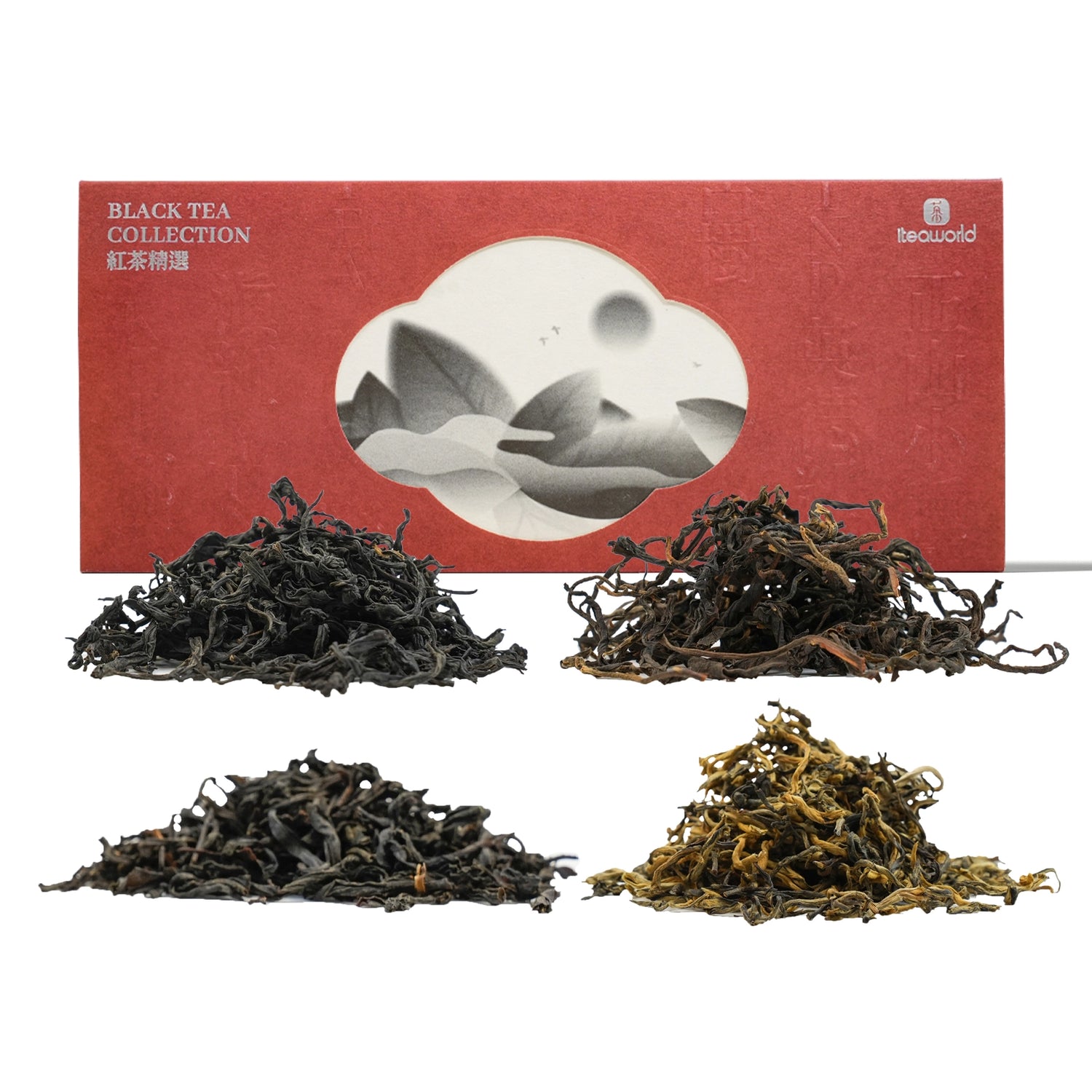
Chinese Black Tea Collection – 4 Premium Teas for Tea Enthusiasts & Gifting 100g
$39.99
Unit price perChinese Black Tea Collection – 4 Premium Teas for Tea Enthusiasts & Gifting 100g
$39.99
Unit price perDiscover Authentic Chinese Black Tea Collection
Chinese black tea has a 400-year heritage and remains deeply rooted in tradition. From the smoky pine notes of Tongmuguan’s classic Zhengshan Xiaozhong, to the refined, fruity aromas of Keemun prized by European royalty, to the full-bodied richness of Yunnan’s ancient-tree Gongfu black tea, each variety tells a unique story. What sets these teas apart is the dedication to traditional, hands-on methods: the leaves are handpicked, sun-wilted, and even slow-dried over charcoal or pinewood fires to preserve their natural shape and complexity. This commitment results in whole-leaf teas with a depth and character far beyond mass-produced, machine-processed black teas.
iTeaworld has curated this premium selection to showcase China’s finest and most diverse black teas, capturing varying fermentation levels and distinct terroir influences. Whether you’re a tea enthusiast looking to experience authentic Chinese flavors or seeking a unique gift, this collection offers a refined tasting journey through China’s rich tea-making legacy.
Note: Chinese high-quality black teas are best enjoyed on their own, without milk or sugar. If you prefer a stronger, milk-friendly tea, this may not be the ideal collection for you. But for those who appreciate nuanced, natural flavors, this set is an invitation to explore a truly exceptional tea experience.
Premium Chinese Black Tea Collection
Featuring the most authentic and popular black teas from China's top regions:
Wuyi Zhengshan Xiaozhong (Lapsang Souchong): 5 packs x 5g
Yunnan Golden Bud Black Tea: 5 packs x 5g
Keemun Black Tea: 5 packs x 5g
Yunnan Ancient Tree Black Tea: 5 packs x 5g
O U R T E A R E G I O N S
Lapsang Souchong (Pine-Smoked) : Tongmu Village, Xingcun Town, Wuyishan City, Fujian Province
Dianhong Golden Buds Black Tea: Fengshan Town, Fengqing County, Yunnan Province
Keemun Black Tea: Ruokeng Township, Qimen County, Anhui Province
Century-Old Tree Black Tea: Jingmai Mountain, Huimin Town, Lancang County, Yunnan Province
The Northern Fujian region is considered the birthplace of Oolong tea, and the traditional crafting methods of Wuyi Rock Tea have been recognized as part of China’s intangible cultural heritage. This collection brings together iconic oolong varieties from the Song Dynasty (Wuyi Qizhong and Jian'ou Dwarf Oolong) to today (Blended Da Hong Pao, Wuyi Rougui, Aged Tree Shuixian Oolong ), along with emerging cultivars with great future potential (Rui Xiang Oolong). Each tea carries the unique craftsmanship of the region, with its own distinct story and flavor. We hope this collection will allow you to explore the diverse flavors and rich cultural heritage of Northern Fujian (Minnan) Oolong tea.
Product Contains:
Wuyi Qizhong*3 bags* 5g
Jian'ou Dwarf Oolong*3 bags* 5g
Blended Da Hong Pao*4 bags* 5g
Wuyi Rougui *4 bags* 5g
Aged Tree Shuixian Oolong*3 bags* 5g
Rui Xiang Oolong*3 bags* 5g
Processing Time: November 2024
Best Before Date: 36 months
Minnan North Oolong Tea: A Cup, A History, A Story
1. Origins (Tang and Song Dynasties)
- The people used Wuyi Caicha (Qi zhong ) to produce Beiyuan tribute tea (a type of steamed green tea). During transportation, the leaves collided, causing some to turn red and undergo partial oxidation, developing semi-fermented characteristics, which are considered the origins of Oolong tea.
2. Birth (Ming Dynasty)
- After Emperor Zhu Yuanzhang banned compressed tea cakes, the tea farmers of Wuyi Mountain combined green and black tea processing techniques to create semi-fermented Oolong tea.
3. Development (Qing Dynasty)
- Wuyi Cai Tea (Qi Zhong): By the Qing Dynasty, Wuyi Rock Tea had established the basic processes of sun-drying, shaking, and roasting. The Wuyi Rock Tea system had matured, with the earliest representative varieties being Wuyi Cai Tea (Qi Zhong) and its derivative four famous cultivars (Da Hong Pao, Bai Ji Guan, Tie Luo Han, Shui Jin Gui).
- Jian'ou Dwarf Oolong: Originally from the Dongfeng Town of Jian'ou, the Dwarf Oolong (also known as Xiao Ye Oolong) was introduced to Wuyi Mountain, where it was improved through craftsmanship, including charcoal roasting, imparting it with signature peachy aroma and strong mineral finish made it a favorite for blending, earning the nickname “Prime Minister of Tea”.
- Wuyi Rougui: Rou Gui, another celebrated rock tea, dates back to the Qing dynasty. It was once rare and scattered in the rocky core of Wuyi, but it expanded in the 1960s through cutting and propagation.
- Wuyi Shui Xian: Shui Xian, introduced from Jianyang in the 1800s, became a Fujian classic thanks to its rich, woody flavor and thick body.
4. Prosperity (20th Century to Present)
- Blended Da Hong Pao: In the 20th century, breakthroughs in asexual reproduction techniques allowed the successful propagation of Da Hong Pao by cutting in 1982, leading to the mass production of pure Da Hong Pao after the mother tree ceased harvesting in 2006.
- Rui Xiang: New hybrid varieties such as Jin Mudan, Huang Guanyin, and Rui Xiang were developed by crossbreeding traditional types like Rou Gui, Shui Xian, and Huang Jin Gui. Rui Xiang, in particular, is known for its ever-changing aroma—from frankincense and gardenia to osmanthus, peach, and honey—earning it the nickname “The Shape-Shifter” of rock teas.
Unique Crafting Characteristics:
1. Heavy Fermentation & Oxidation
Northern Fujian oolong follows a unique processing style: longer withering under sunlight, light but repeated shaking, multiple oxidation cycles, and deep fermentation. Compared to Southern Fujian oolongs (which are 10%-30% oxidized), Northern Fujian oolongs range from 25-55% oxidation, giving the tea a rich amber-gold color and a smoother, more full-bodied taste.
2. Charcoal Roasting Process
Charcoal roasting is a signature technique of Northern Fujian Oolong teas. It involves three key stages:
Initial Roast ("Water Walk"): High heat (~150°C) is used to quickly remove surface moisture and grassy notes.
Second Roast (Slow Roast): A gentle, extended roast lasting 10-18 hours, with the temperature gradually lowered to ~80°C. This stage develops rich caramel and mineral notes.
Final Roast (Aging Roast): A very low, slow roast at 60–80°C for 12-24 hours. This step reduces the leaf’s moisture to 3–5%, boosting shelf life and aging potential.
Only dense hardwood charcoal—like longan or lychee wood—is used to ensure a steady, even roast.
This traditional method produces a warm, rounded flavor with a deep roasted aroma, offering a smoother and more refined character than the sharper taste of electric-roasted teas.
3. Rolling & Shaping
No Ball-Rolling – Unlike Southern Fujian oolongs, Northern Fujian oolongs are not tightly rolled, preserving their long, twisted leaf shape with a glossy dark hue and reddish-brown highlights.
Double Frying & Rolling – The tea is fried and rolled twice, ensuring an even release of its inner essence and creating a thicker, silkier tea liquor.
Brewing Recommendations:
Teaware:
Gaiwan (110- 150ml): Best for aromatic teas (Rougui, Dangui).
Yixing Clay Teapot: Ideal for heavily roasted or aged teas.
Water:
Use 100°C (boiling) spring or purified water.
Tea-to-Water Ratio:
5g tea / 110ml water.
Brewing Tips:
Preheat & awaken tea.
High pour for aroma, low pour for smoothness.
Quick steeps (5-10s) for first 3 infusions, then extend.
Fully drain after each brew.
The production of Oolong tea in the Southern Fujian region dates back to the 17th century, with a wide variety of Oolong teas. Among them, the famous Tie Guan Yin and Zhangping Shui Xian have been officially recognized as part of China’s Intangible Cultural Heritage.
This curated collection showcases oolong varieties discovered and cultivated in Southern Fujian, offering a glimpse into its evolving tea history and distinct flavor profiles. Whether you’re a seasoned tea drinker or a curious explorer, this selection lets you experience the true essence of Southern Fujian oolong.
The selection includes:
Qingxiang Tieguanyin (Light Aroma Tieguanyin)* 3 bags* 5 g
Nongxiang Tieguanyin (Strong Aroma Tieguanyin) * 3 bags* 5 g
Qingxiang Huangjingui (Light Aroma Huangjingui)* 3 bags* 5 g
Zhangping Shuixian (Pressed Shuixian from Zhangping)* 3 bags* 5 g
Yongchun Fo Shou (Yongchun Buddha’s Hand, Fruity Aroma)* 2 bags* 5 g
Qingxiang Baiya Qilan (Light Aroma Baiya Qilan)* 2 bags* 5 g
Nongxiang Meizhan (Strong Aroma Meizhan)* 2 bags* 5 g
Qingxiang Daye Oolong (Light Aroma Big Leaf Oolong)* 2 bags* 5 g
Processing Time: May 2024
Best Before Date: 36 months
Southern Fujian (Minnan)Oolong Tea: A Flavor for Every Era
1. Origins (Kangxi Period, Qing Dynasty)
Anxi is the birthplace of Minnan Oolong tea. During the Qing Dynasty's Kangxi period, a Yongchun monk grafted Anxi tea plants with native citron trees, creating the unique Yongchun Fo Shou tea, known for its distinctive fruity aroma and mineral depth.
2. Golden Age (from Qianlong to Xianfeng Periods, Qing Dynasty)
In the 18th century, Minnan Oolong entered its golden age. Wang Shiran from Anxi discovered a rare tea tree and made tea from it, which was presented to Emperor Qianlong. The tea was named Tie Guan Yin, due to its "iron-like weight" and "Guanyin-like shape." With its bold flavor and growing demand in Southeast Asia, it became a major export tea.
In the Xianfeng period, Anxi tea farmers selected and cultivated the Huang Jin Gui. Known for its osmanthus-like fragrance, it became a symbol of Minnan’s high-aroma Oolong teas.
3. Transformation (Late 19th to Early 20th Century)
To meet the needs of overseas markets, Minnan tea farmers developed Mei Zhan and Da Ye Oolong. Meanwhile, Zhangping Shui Xian evolved its unique "square tea cake" shape, becoming the only compressed Oolong tea.
Mei Zhan: Noted for fruity sweetness and strong infusions
Da Ye Oolong: Known for its thick texture and caramel notes, great for blending
Zhangping Shui Xian: Complex fragrance with intertwined orchid and osmanthus notes, smooth and refreshing taste.
4. Innovation (Beginning of the 20th century)
As technology advanced, Minnan Oolong entered a new era. In the 1980s, Pinghe County discovered Bai Ya Qi Lan, celebrated for its crisp orchid aroma.
Unique Crafting Characteristics:
- The fermentation level is typically between 10% and 25%, making it a lightly fermented Oolong tea.
- The repeated rolling and wrapping for the Shaping process is a key feature that distinguishes Minnan Oolong from other Oolong teas, shaping its unique appearance.
- Multiple rounds of slow roasting at low heat are used to enhance the tea's aroma.
- The leaves undergo multiple cycles of shaking and resting to achieve the perfect balance of "three reds and seven greens" in the leaf base.
How to Brew Minnan Oolong?
1. Choose the Right Teaware
White porcelain gaiwan – Best for lightly oxidized, lightly roasted oolongs, as it preserves delicate floral notes.
Yixing clay teapot – Ideal for richer, heavily roasted or charcoal-roasted oolongs, enhancing depth and smoothness.
2. Water Temperature Matters
Use boiling water (100°C / 212°F) for full aroma and body.
Water below 90°C (194°F) results in weaker flavor and muted fragrance.
3. Tea-to-Water Ratio
7–8g of tea for a 110ml gaiwan (about ⅓ full).
Standard ratio: 1:15 (tea to water)—adjust based on preference.
4. Use the Right Water
Soft, slightly alkaline spring water or purified water is best.
Avoid tap water with high mineral content, as it can mute the tea’s natural flavors.
5. Preheat Your Teaware
Rinse the gaiwan and cups with boiling water before brewing.
This warms the vessels and prevents temperature shock, allowing the aroma to bloom fully.
6. Wake Up the Tea (Rinse Infusion)
Pour boiling water over the leaves and immediately discard (within 10 seconds).
This removes any impurities and "wakes up" the leaves for optimal flavor release.
7. Proper Pouring Technique
Pour water gently along the inner wall of the gaiwan.
This helps the leaves unfurl evenly and enhances the fragrance.
8. First Infusion Timing
7–15 seconds for the first steep:
Lightly roasted teas need a shorter steep.
Heavily roasted teas can steep slightly longer.
9. Subsequent Infusions
Increase steep time by 5–10 seconds per infusion.
High-quality oolong can last 7–10 brews, with longer-lasting flavor in premium-grade teas.
10. Drain Completely Between Steeps
Always pour out all the liquid after each infusion.
This prevents oversteeping, which can lead to bitterness or astringency in later brews.

Guangdong Oolong Tea Collection: 6 Historical Flavors for Tea Lovers 100g
$49.99
Unit price perGuangdong Oolong Tea Collection: 6 Historical Flavors for Tea Lovers 100g
$49.99
Unit price perIn Guangdong, tea drinking has long been a part of daily life. With a rich history of tea cultivation, the region has developed a deep-rooted tea culture and a diverse range of Oolong teas with distinctive craftsmanship and flavors. This collection traces the footsteps of Guangdong Oolong through history, gathering the most iconic teas from ancient traditions to modern favorites. We hope this product allows you to experience the unique charm of Guangdong Oolong tea.
The product includes:
Fenghuang Lancai Oolong* 3 bags* 5 g
Shiguping Oolong* 3 bags* 5 g
Fenghuang Dancong Honey Orchid (Mi Lan Xiang)* 4 bags* 5 g
Ya Shi Xiang Dancong* 3 bags* 5 g
Lingtou Dancong* 4 bags* 5 g
Xiyan Oolong* 3 bags* 5 g
Processing Time: November 2024
Best Before Date: 36 months
What Makes Guangdong Oolong Tea So Special?
1. A Long and Rich History
Guangdong’s tea-making traditions date back as early as the Song Dynasty. By the late Ming and early Qing periods, Oolong tea processing techniques were introduced to Guangdong, marking the beginning of its unique Guangdong Oolong tea history.
- Initially, Fenghuang shuixian and Shiguping Oolong were respectively made from the mother plant of Guangdong Oolong Tea (Fenghuang shuixian group species) and the small-leaf shrub tea trees cultivated in the She ethnic village.
- In the early 20th century, premium cultivars like Mi Lan Xiang (Honey Orchid Aroma) and Ya Shi Xiang (Duck Shit Aroma) were selected from the Fenghuang Shui Xian group spcies.
- In 1962, Lingtou Dancong was created in Lingtou Village, Raoping Town, Chaozhou, using a natural mutation of the Fenghuang Shui Xian group species known for its pronounced honey fragrance.
- In the 1970s, Xiyan Oolong emerged in the Xiyan Mountain region of Meizhou, combining Lingtou Dancong and Qilan cultivars to create a tea known for its high-mountain aroma.
2. Unique Craftsmanship
- High-quality fresh leaves are handpicked from single tea trees and processed individually.
- The fixation step uses a high-temperature, rapid method to lock in the tea’s fresh aroma and active compounds.
- The shaking process emphasizes evenness and multiple rounds to enhance the transformation of aromatic substances.
- Extended light fermentation develops a fuller, more transparent floral fragrance.
- Roasting is typically done at medium levels or low levels, with adjustments based on the tea’s aroma type and cultivar. The goal is to preserve the fresh aroma while adding body to the tea liquor. Roasting is carried out gradually in stages, avoiding damage to the aroma from sudden high heat.
How to brew?
Teaware: 110ml Gaiwan or Yixing Clay Teapot
Preheat all teaware with boiling water to enhance aroma.
Water Temp: 212°F (100°C)
Tea-to-Water Ratio: 5g per session
Steeping Time: 1–3 infusions: 15 sec
Later infusions: Add 5–10 sec
Total brews: 7–10 times
Water Quality: Spring or mineral water preferred
Pouring Tips:
High pour to awaken the aroma
Fixed-point pour for even extraction
Quick pour-out to prevent bitterness
Fully drain each brew for the best taste
Fenghuang Dancong 10 Aromas Collection
Discover the essence of Chinese Gongfu tea culture with this unique Fenghuang Dancong oolong tea set, featuring 10 distinct natural aromas like Jasmine, Gardenia, Honey Orchid, and more. Known as the "perfume of tea," this collection showcases the diverse flavors created by different tea bush varieties from Fenghuang Town, the heart of Dancong tea production.
Whether you’re a fan of fragrant teas, a Gongfu tea enthusiast, or simply curious about the rich aromas and flavors of oolong tea, this set offers a sensory journey you won’t forget. Beautifully curated, it’s an ideal gift for tea lovers who appreciate authentic, aromatic, and high-quality teas.
What is Fenghuang Dancong tea?
Fenghuang Dancong tea is a type of oolong tea, which is selected and bred from the Fenghuang Shuixian group. Each individual plant has its own unique shape and variety, forming its own product line, hence the name "Dancong," which means "single bush" or "single strain." This tea is mainly characterized by its ability to withstand multiple infusions, its strong aftertaste, and its high, lingering aroma. It's known as the most fragrant oolong tea due to its distinctive fragrance. Based on different aromatic types, Fenghuang Dancong is divided into various scented categories.
The product includes:
Fenghuang Dancong Oolong Tea(Huang Zhi Fragrance)2*5g
Fenghuang Dancong Oolong Tea(Orchid Fragrance)2*5g
Fenghuang Dancong Oolong Tea(Honey Orchid Fragrance)2*5g
Fenghuang Dancong Oolong Tea(Magnolia Fragrance)2*5g
Fenghuang Dancong Oolong Tea(Ginger Flower Fragrance)2*5g
Fenghuang Dancong Oolong Tea(Osmanthus Aroma)2*5g
Fenghuang Dancong Oolong Tea(Cinnamon Fragrance)2*5g
Fenghuang Dancong Oolong Tea(Almond Fragrance)2*5g
Fenghuang Dancong Oolong Tea(Night-scented Stock)2*5g
Fenghuang Dancong Oolong Tea(Jasmine Fragrance)2*5g
Origin:
Fenghuang Town, Chaozhou City, Guangdong Province.
Introduction to the Top 10 Fragrance Types of Fenghuang Dancong Tea
Fenghuang Dancong Oolong Tea(Huang Zhi Fragrance):A high-quality single bush tea with a natural gardenia fragrance.
Fenghuang Dancong Oolong Tea(Orchid Fragrance):Features the aroma of orchids, fresh and subtle.
Fenghuang Dancong Oolong Tea(Honey Orchid Fragrance):The most popular type, known for its strong honey flavor combined with orchid fragrance, hence the name Milan.
Fenghuang Dancong Oolong Tea(Magnolia Fragrance): Fresh and elegant, with the aroma of magnolia flowers.
Fenghuang Dancong Oolong Tea(Ginger Flower Fragrance):Also known as 'Penetrating Heaven Fragrance', named for the uplifting ginger flower scent when the tea is brewed.
Fenghuang Dancong Oolong Tea(Osmanthus aroma): Reminiscent of osmanthus flowers, sweet and lingering.
Fenghuang Dancong Oolong Tea(Cinnamon Fragrance): Named for the tea's flavor that resembles the taste of cinnamon, a traditional Chinese medicine.
Fenghuang Dancong Oolong Tea(Almond Fragrance):Also known as 'Sawtooth', named for the serrated edges of the leaves, with a distinct almond aroma.
Fenghuang Dancong Oolong Tea(Night-scented Stock): Night-scented Stock Dancong is famous for its unique evening fragrance and flavor. It's mainly produced in Fengxi Dan Lake, Fenghuang Town, and is quite rare.
Fenghuang Dancong Oolong Tea(Jasmine Fragrance): A unique fragrance type with the scent of jasmine flowers, refreshing and delightful.
Brewing Tips
Recommended Method: Traditional Gongfu style.
Best Teaware: White porcelain gaiwan or Yixing clay teapot.
Tea-to-Water Ratio: Use 5g of tea for 100ml of water.
Water Temperature: 212℉ (100℃).
Steeping Times:
First rinse: Quick pour, discard the rinse.
2nd–5th infusions: Steep for 6–8 seconds.
6th–10th infusions: Steep for 10–15 seconds.
Brewing Durability: Authentic Dancong from Chaozhou's Fenghuang region can be steeped 12–15 times.
Technique: Pour water along the edge of the gaiwan in a steady stream. Tilt the lid slightly to leave a small gap to prevent over-steaming.
A semi-fermented oolong tea grown in the rocky crevices of Fujian’s Wuyi Mountain, renowned for its unique "rock bone floral aroma" (Yan Yun). Only tea cultivated within Wuyi City’s protected region can bear this name. Other areas (e.g., Anxi) do not produce Rock Tea.
This collection features the three most iconic Wuyi rock teas—Da Hong Pao, Shuixian, and Rougui—along with their key variations. You’ll taste the difference between blended and purebred Da Hong Pao, young and old Shuixian trees, and core vs. semi-core Rougui. A guided journey into the depth and complexity of Wuyi rock tea.
How to Start with Wuyi Rock Tea?
For newcomers, we recommend starting with Blended Da Hong Pao, Shuixian, and Rougui—classic, accessible, and well-balanced teas that offer a great introduction to Wuyi Rock Tea.
Blended Da Hong Pao – The most famous Wuyi Rock Tea, blended for a harmonious taste of rock minerality, floral-fruity notes, and roasted depth. The perfect benchmark for beginners.
Shuixian – Smooth and mellow with woody sweetness and a lingering finish. Ideal for those who prefer a rich, rounded texture.
Rougui – Spicy cinnamon aroma with a bold, warming character. A great choice for adventurous palates.
Why start with these?
Easy to find – Widely available & consistent in quality.
Affordable – Great value for authentic Wuyi Rock Tea.
Versatile – Covers the core flavor profiles of "Yan Yun" (rock essence)。
Product Contains:
Traditional Blend Dahongpao* 3 bags* 5 g
Qidan Purebred Dahongpao*3 bags* 5 g
Queshe Purebred Dahongpao* 3 bags* 5 g
New Growth Wuyi Shuixian* 3 bags* 5 g
Aged Tree Wuyi Shuixian*3 bags* 5 g
BanYan Wuyi Rougui* 3 bags* 5 g
ZhengYan Wuyi Rougui* 2 bags* 5 g
Tea Master: Chen Hui 陈辉
Origin: Jingshui Village, Xingcun Town, Wuyishan City, Fujian Province
Processing Time: November 2024
Best Before Date: 36 months
Elevation: 400-600 meters
Soil: Gravel soil
Oxidation: 45-55%
Roast Level: Medium fired
Roasting Method: charcoal roasting
How to Brew Wuyi Rock Tea?
Water: Use filtered or spring water (avoid hard water).
Teaware: Yixing clay teapot for medium-high roast; porcelain gaiwan for lighter roast.
Awakening: Aged tea: dry wake for 1 hour; new tea: optional.
Temperature: 95–100°C (203–212°F).
Tea-to-Water Ratio: 5g per 90–100ml (1:20).
Steeping: First 3 infusions: 5–10 sec; increase by 5–10 sec after. 8–10 infusions total.
Aged Shui Xian: First steep 20 sec to enhance aroma.
Tips:
Light roast (Que She, new Shui Xian): Avoid prolonged high heat.
Full roast (Beidou, aged tea): Use boiling water to activate flavors.
Boiling water for bold teas (Rou Gui, Beidou): lower temp for delicate teas (Que She, new Shui Xian).
Who would enjoy this tea?
This collection is perfect for those who have explored the classic Wuyi rock teas and are ready to dive deeper into its rare and distinctive varieties. It includes historically renowned teas like Tie Luohan, Bàn Tiān Yāo, Bai Ji Guan, Shui Jin Gui, and Bai Rui Xiang, along with newer, highly sought-after cultivars like Rui Xiang and Jin Mudan. A journey through the diverse flavors and craftsmanship of Wuyi rock tea.
Product Contains:
Tie Luohan (Iron Arhat)* 3 bags* 5 g
Bai Jiguang (White Cockscomb)* 3 bags* 5 g
Shui Jin Gui (Golden Water Turtle)* 4 bags* 5 g
Bantian Yao (Half-Heaven Goblin)* 3 bags* 5 g
Jin Mudan (Golden Peony)* 4 bags* 5 g
Bairuixiang (Hundred-Fragrance Orchid) * 3 bags* 5 g
Tea Master: Chen Hui 陈辉
Origin: Jingshui Village, Xingcun Town, Wuyishan City, Fujian Province
Processing Time: November 2024
Best Before Date: 36 months
Elevation: 400-600 meters
Soil: Gravel soil
Oxidation: 45-55%
Roast Level: Medium fired
Roasting Method: charcoal roasting
Rare Wuyi Rock Tea Cultivars: Hidden Gems from the Core of Zhengyan
While teas like Da Hong Pao, Rou Gui, and Shui Xian have become well-known representatives of Wuyi Rock Tea, the rare cultivars—such as Tie Luo Han, Bai Ji Guan, Shui Jin Gui, and Ban Tian Yao—tell a deeper, more authentic story. These teas originate from wild, heirloom tea trees that have grown for centuries in the heart of the Wuyi Mountains, shaped by natural selection and careful cultivation. They embody the original genetic heritage of Wuyi rock tea.
Grown on remote cliffs and craggy ledges in the Zhengyan core production zone—places like Guidong Cave and Sanhua Peak—these tea trees sink their roots deep into rocky crevices, drawing in rare minerals. The result is a flavor profile marked by the elusive and unmistakable "Yan Yun" (rock rhyme) that connoisseurs revere.
Each rare cultivar delivers its own singular flavor experience:
Bai Ji Guan offers a light, sweet corn silk aroma.
Tie Luo Han reveals warming, herbal notes reminiscent of angelica root.
Ban Tian Yao stuns with an exotic bouquet of gardenia, milk, and honey—complex and unforgettable.
Their scarcity only adds to their mystique. For example, Ban Tian Yao yields less than 100 pounds annually. Yet despite their low production, these cultivars have a devoted following among seasoned tea drinkers and collectors. One standout, Rui Xiang, is prized as a “secret weapon” in premium blends for its piercing, long-lasting aroma.
These teas are more than just flavor—they’re living cultural heritage.
Bai Ji Guan has Taoist roots.
Shui Jin Gui is tied to legends of a golden tortoise seeking justice.
Tie Luo Han was once a top export to Southeast Asia.
In an age of mass production and standardized flavor, these rare Wuyi cultivars offer a bold alternative: complexity, character, and a deep connection to terroir. Their resilience—thriving in shade and drought—also holds promise for future tea breeding.
As local tea farmers say, “Rou Gui represents today, but the rare cultivars lead us into tomorrow.” Exploring them is like reading a living encyclopedia of Wuyi Rock Tea—each sip a page from nature’s own archive.
How to brew these teas?
-
Core Principles
Teaware: Use a porcelain gaiwan (best for aroma) or Yixing clay teapot (enhances richness).
Water: Filtered or spring water (avoid hard water). Temperature: Boiling (100°C/212°F) for medium/heavy roasted teas; 90-95°C (194-203°F) for light roasted teas.
Ratio: 1:20 tea-to-water (e.g., 5g/3.8oz tea for 110ml/3.8oz water). -
Brewing Steps
Warm the Teaware: Rinse cups and teapot with hot water to unlock aromas.
First Rinse: Pour boiling water over leaves and discard immediately (awakens tea).
Brewing:
Short Steeps: Start with 5-10 seconds for the first 3 infusions.
Gradually Increase: Add 5-10 seconds per subsequent steep.
Avoid Oversteeping: Prevents bitterness.
Pro Tips for Westerners
Flavor Clues:
"Rock Essence" (Yan Yun): A mineral aftertaste like wet stones—sign of quality
Cold Cup Test: Smell the empty cup after sipping. True Wuyi teas retain alpine herb/plum notes
Fix Bitterness: Reduce steeping time or use cooler water (88-90°C).
Pairings: Dark chocolate (for heavy roasts) or lemon tart (for light roasts).
Why this product?
Many people are unclear about what qualifies as aged tea and how to tell the age of tea. iTeaworld has been working with aged tea in the Chinese market for 20 years. We believe that for tea to be considered "aged," it should meet these three criteria: 1. It should have an aged or woody aroma. 2. The tea liquor should be smooth, rich, and sweet. 3. There should be a noticeable warm sensation in the body, especially in the hands and feet, after drinking.
Based on this standard, we’ve selected 10 aged teas, including Oolong, black tea, white tea, dark tea, Pu-erh, and green tea, to help tea lovers understand what aged tea really is.
The product includes:
1995 Shui Xian Oolong Tea: 2 packs of 5g each
1998 Tie Guan Yin Oolong Tea: 2 packs of 5g each
1995 Fenghuang Dancong Oolong Tea: 2 packs of 5g each
1998 Raw Pu-erh Tea : 2 packs of 5g each
2003 Ripe Pu-erh Tea : 2 packs of 5g each
2008 Shuangzheng Liu Bao Dark Tea: 2 packs of 5g each
2014 Shou Mei White Tea: 2 packs of 5g each
2014 Lapsang Souchong Black Tea: 2 packs of 5g each
1998 Jasmine Green Tea: 2 packs of 5g each
1980s Aged Fu Brick Dark Tea: 2 packs of 5g each
How to brew:
Brewing utensils: White porcelain Gaiwan or Zisha teapot.
Water temperature: 95°C-100°C
Tea-to-water ratio: 1:15-25
Brewing time: 10-20seconds
Number of brews: 5-7 times
Why Aged Tea is Still Drinkable:
The reason aged tea can still be consumed safely lies in the unique chemistry of tea leaves and traditional storage methods. Tea contains powerful antioxidants like catechins and polyphenols, which naturally help slow oxidation, keeping tea consumable for extended periods. Dried tea absorbs only minimal moisture and oxygen, meaning it doesn’t provide the damp environment that bacteria need to grow. As long as tea is stored properly—dry, cool, and sealed against odors—it won’t spoil easily, and you can enjoy it without worries if there’s no mold or strange smells.
How Different Types of Tea Age:
Dark Tea (Hei Cha)
Dark tea, when properly aged, undergoes microbial transformations that mellow its flavor. Over time, compounds like caffeine and polyphenols break down, shifting the taste from bitter to smooth and rich. Dark tea requires specific storage conditions: dry, airy, and cool, to support this mellowing process.
White Tea
In China, there’s a saying about white tea: "One-year tea, three-year medicine, seven-year treasure." Aging for three years or more brings out richer flavors and enhances its perceived medicinal value. As white tea ages, the leaves soften in flavor and aroma, creating a more layered drinking experience.
Black Tea
Black tea generally maintains its natural sweetness and fragrance over time, and since its flavor doesn’t improve with aging, most black teas are best enjoyed fresh. However, certain types of compressed black teas, like Hunan's Fu Brick, can develop deeper flavors with storage due to gradual microbial changes.
Oolong Tea
Roasted Oolong teas like Wuyi Rock Tea (Yan Cha) gain complexity as they age. The roasted notes soften, and the tea develops a distinctive “aged aroma,” adding richness and hints of sweetness. Proper storage is essential to preserve its unique characteristics: keep it dry, away from direct sunlight, and sealed to maintain freshness.
Jasmine Green Tea
Jasmine Green Tea, infused with fresh jasmine flowers, has a unique floral aroma that is best enjoyed within one or two years. Over time, the green tea component oxidizes, leading to a darker color and a softer floral note. To preserve the jasmine aroma and freshness, it’s ideal to store it sealed, in a cool, dry place, or even refrigerate it if possible.




